

INSTRUCTOR’S SOLUTIONS MANUAL
TIM BRITT
Jackson State Community College
T RIGONOMETRY :
A U NIT C IRCLE A PPROACH
TWELFTH EDITION
Michael Sullivan
Chicago State University

Copyright © 2025, 2021, 2017 by Pearson Education, Inc. or its affiliates. All Rights Reserved. Manufactured in the United States of America. This publication is protected by copyright, and permission should be obtained from the publisher prior to any prohibited reproduction, storage in a retrieval system, or transmission in any form or by any means, electronic, mechanical, photocopying, recording, or otherwise. For information regarding permissions, request forms, and the appropriate contacts within the Pearson Education Global Rights and Permissions department, please visit www.pearsoned.com/permissions/
PEARSON and MYLAB are exclusive trademarks owned by Pearson Education, Inc. or its affiliates in the U.S. and/or other countries.
Unless otherwise indicated herein, any third-party trademarks, logos, or icons that may appear in this work are the property of their respective owners, and any references to third-party trademarks, logos, icons, or other trade dress are for demonstrative or descriptive purposes only. Such references are not intended to imply any sponsorship, endorsement, authorization, or promotion of Pearson’s products by the owners of such marks, or any relationship between the owner and Pearson Education, Inc., or its affiliates, authors, licensees, or distributors
Table of Contents
Chapter 1 Preliminaries
Chapter 2 Functions and Their Graphs
Chapter 3
3.1
Chapter 4 Analytic Trigonometry
4.1
4.2
Chapter 5 Applications of Trigonometric Functions
5.1
5.3
5.4
5.5
Chapter 6 Polar Coordinates; Vectors
6.1
6.3
6.4
6.5
6.6
6.7
Chapter 7 Analytic Geometry
7.2
Chapter 8 Exponential and Logarithmic Functions
8.7
Appendix A Review
A.1 Algebra Essentials .................................................................................................................. 844
A.2 Geometry Essentials ............................................................................................................... 849
A.3 Polynomials............................................................................................................................ 855
A.4 Solving Equations .................................................................................................................. 863
A.5 Complex Numbers; Quadratic Equations in the Complex Number System .......................... 877
A.6 Problem Solving: Interest, Mixture, Uniform Motion, Constant Rate Job Applications ....... 883
A.7 Interval Notation; Solving Inequalities .................................................................................. 890
A.8 nth Roots; Rational Exponents ................................................................................................ 902
Appendix B Graphing Utilities
B.1 The Viewing Rectangle .......................................................................................................... 912
B.2 Using a Graphing Utility to Graph Equations ........................................................................ 913
B.3 Using a Graphing Utility to Locate Intercepts and Check for Symmetry .............................. 918
B.5 Square Screens ....................................................................................................................... 920
Chapter 1 Preliminaries
Section 1.1
1. 0
2. 5388
3. 22 34255
4. 22 116012136003721612
Since the sum of the squares of two of the sides of the triangle equals the square of the third side, the triangle is a right triangle.
5. 1 2 bh
6. true
7. x-coordinate or abscissa; y-coordinate or ordinate
8. quadrants
9. midpoint
10. False; the distance between two points is never negative.
11. False; points that lie in Quadrant IV will have a positive x-coordinate and a negative y-coordinate. The point 1,4 lies in Quadrant II.
12. True; 1212 , 22 x xyy M
13. b
14. a
15. (a) Quadrant II
(b) x-axis
(c) Quadrant III
(d) Quadrant I (e) y-axis
(f) Quadrant IV

16. (a) Quadrant I
(b) Quadrant III
(c) Quadrant II
(d) Quadrant I
(e) y-axis
(f) x-axis

17. The points will be on a vertical line that is two units to the right of the y-axis.
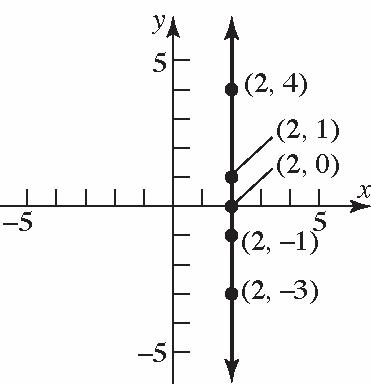
18. The points will be on a horizontal line that is three units above the x-axis.
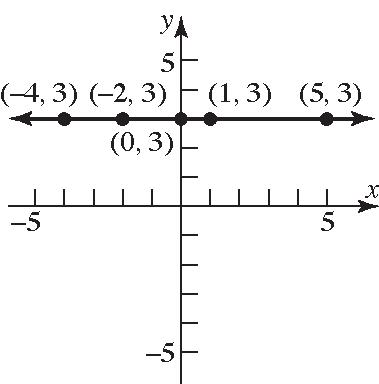
dPP
19. 22 12 22 (,)(20)(10) 21415
dPP
20. 22 12 22 (,)(20)(10) (2)1415
dPP
21. 22 12 22 (,)(21)(21) (3)19110
dPP
22. 2 2 12 22 (,)2(1)(21) 319110
23.
dPP
2 2 12 2 2 (,)(53)44 2846468217
dPP
24.
2 2 12 2 2 (,)2140 34916255
dPP
25. 2 2 12 22 (,)4(7)(03) 11(3)1219130
26. 22 12 22 (,)422(3) 2542529 dPP
dPP
27. 2 2 12 22 (,)(65)1(2) 131910
28. 22 12 22 (,)6(4)2(3) 10510025 12555 dPP
dPP
29. 22 12 22 (,)2.3(0.2)1.1(0.3) 2.50.86.250.64 6.892.62
dPP
30. 22 12 22 (,)0.31.21.12.3 (1.5)(1.2)2.251.44 3.691.92
31. 22 12 2222 (,)(0)(0) ()() dPPab abab
32. 22 12 22 222 (,)(0)(0) ()() 22 dPPaa aa aaaa
33. (2,5),(1,3),(1,0)ABC
dAB dBC dAC
2 2 22 2 2 22 2 2 22 (,)1(2)(35) 3(2)9413 (,)11(03) (2)(3)4913 (,)1(2)(05) 1(5)12526
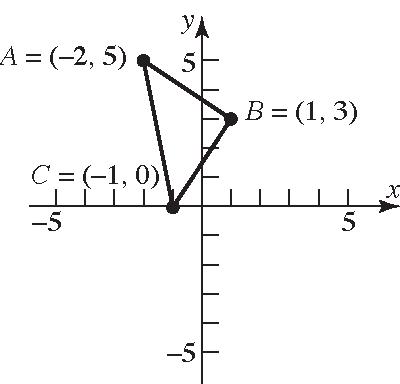
Verifying that ∆ ABC is a right triangle by the Pythagorean Theorem:
The area of a triangle is 1 2 A bh . In this problem,
1964200
(,)1012(113) (2)(14) 4196200 102 (,)10(2)(115) 12(16) 144256400 20 dAB dBC dAC

Verifying that ∆ ABC is a right triangle by the Pythagorean Theorem:
Section1.1: The Distance and Midpoint Formulas
222 22 2 (,)(,)(,) 10210220 200200400 400400 dABdBCdAC
The area of a triangle is 1 2 A bh . In this problem, 1 (,)(,)
35. (5,3),(6,0),(5,5)ABC
dAB dBC dAC
2 2 22 2 2 22 2 2 22 (,)6(5)(03) 11(3)1219 130 (,)56(50) (1)5125 26 (,)5(5)(53) 1021004 104 226
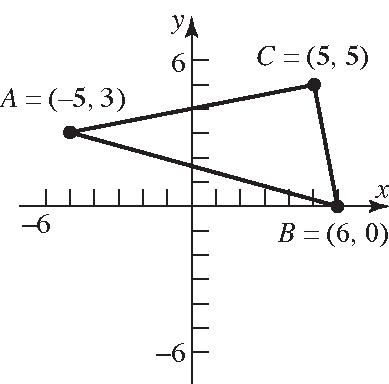
Verifying that ∆ ABC is a right triangle by the Pythagorean Theorem:
The area of a triangle is 1 2 A bh . In this problem,
(,)3(6)(53) 9(8)8164 145 (,)13(5(5)) (4)1016100 116229 (,)1(6)(53) 52254 29 dAB dBC dAC

Verifying that ∆ ABC is a right triangle by the Pythagorean Theorem:
222 222 (,)(,)(,) 29229145 29429145 29116145 145145 dACdBCdAB The area of a triangle is 1 2 A bh . In this problem,
1 (,)(,) 2 1 29229 2 1 229 2 29 square units A dACdBC
37. (4,3),(0,3),(4,2)ABC
2 2 22 22 22 2 2 22 (,)(04)3(3) (4)0160 16 4 (,)402(3) 451625 41 (,)(44)2(3) 05025 25 5 dAB dBC dAC
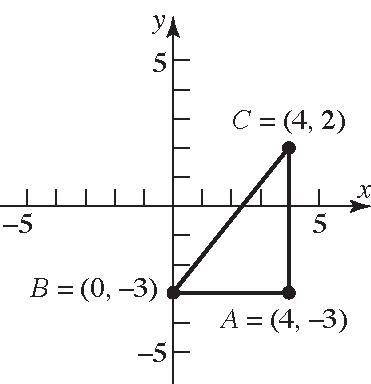
Verifying that ∆ ABC is a right triangle by the Pythagorean Theorem:
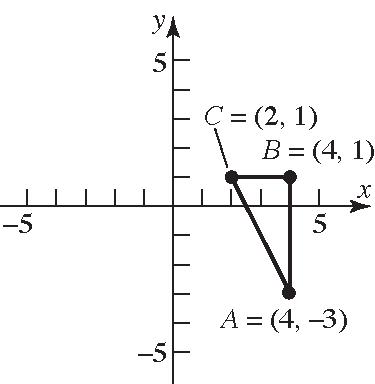
Verifying that ∆ ABC is a right triangle by the Pythagorean Theorem:
Section1.1: The Distance and Midpoint Formulas
22 (,)(,)(,) 4225 16420 2020 dABdBCdAC
The area of a triangle is 1 2 A bh . In this problem,
1 (,)(,) 2
39. The coordinates of the midpoint are: (,),1212 22 44 35 , 22 80 , 22 (4,0) x xyy xy
40. The coordinates of the midpoint are: (,),1212 22 2204 , 22 04 , 22 0,2 x xyy xy
41. The coordinates of the midpoint are: (,),1212 22 1840 , 22 74 , 22 7 ,2 2
x xyy xy
42. The coordinates of the midpoint are: (,),1212 22 2432 , 22 61 , 22 1 3, 2 x xyy xy
43. The coordinates of the midpoint are: (,),1212 22 7951 , 22 4 16 , 22 (8,2)
x xyy xy
44. The coordinates of the midpoint are: (,),1212 22 42 32 , 22 21 , 22 1 1, 2 x xyy xy
45. The coordinates of the midpoint are: (,),1212 22 00 , 22 , 22 x xyy xy ab ab
46. The coordinates of the midpoint are: (,),1212 22 00 , 22 , 22 x xyy xy
47. The x coordinate would be 235 and the y coordinate would be 523 . Thus the new point would be 5,3
48. The new x coordinate would be 123 and the new y coordinate would be 6410 . Thus the new point would be 3,10
49. a. If we use a right triangle to solve the problem, we know the hypotenuse is 13 units in length. One of the legs of the triangle will be 2+3=5. Thus the other leg will be: 222 2 2 513 25169 144 12 b b b b
Thus the coordinates will have an y value of 11213 and 11211 . So the points are 3,11 and 3,13 .
b. Consider points of the form 3, y that are a distance of 13 units from the point 2,1 .
22 2121 22 22 2 2 3(2)1 51 2512 226 dxxyy y y yy yy
2 2 22 2 2 13226 13226 169226 02143 01113 yy yy yy yy yy
110 11 y y or 130 13 y y
Thus, the points 3,11 and 3,13 are a distance of 13 units from the point 2,1
50. a. If we use a right triangle to solve the problem, we know the hypotenuse is 17 units in length. One of the legs of the triangle will be 2+6=8. Thus the other leg will be:
Thus the coordinates will have an x value of 11514 and 11516 . So the points are 14,6 and 16,6 .
b. Consider points of the form ,6 x that are a distance of 17 units from the point 1,2
2 2 22 2 2 17265 17265 289265 02224 01416 xx xx xx xx xx
140 14 x x or 160 16 x x Thus, the points 14,6 and 16,6 are a distance of 13 units from the point 1,2
51. Points on the x-axis have a y-coordinate of 0. Thus, we consider points of the form ,0x that are a distance of 6 units from the point 4,3
22 2121 22 2 2 2 2 430 1683 1689 825 dxxyy x xx xx xx
2 2 22 2 2 2 6825 6825 36825 0811 (8)(8)4(1)(11) 2(1) 864448108 22 863 433 2 xx xx xx xx x
433 x or 433 x
Thus, the points 433,0 and 433,0 are on the x-axis and a distance of 6 units from the point 4,3 .
52. Points on the y-axis have an x-coordinate of 0. Thus, we consider points of the form 0, y that are a distance of 6 units from the point 4,3
22 2121 22 22 2 2 403 496 1696 625 dxxyy y yy yy yy
325 y or 325 y
Thus, the points 0,325 and 0,325 are on the y-axis and a distance of 6 units from the point 4,3
53. a. To shift 3 units left and 4 units down, we subtract 3 from the x-coordinate and subtract 4 from the y-coordinate. 23,541,1
b. To shift left 2 units and up 8 units, we subtract 2 from the x-coordinate and add 8 to the y-coordinate.
22,580,13
54. Let the coordinates of point B be ,x y . Using the midpoint formula, we can write
18 2,3, 22 x y
. This leads to two equations we can solve.
Point B has coordinates 5,2 .
55. 1212 ,,22 x xyy Mxy
111,(3,6) Pxy
and (,)(1,4) xy , so
Thus, 1 (3,6) P . 57. The midpoint of AB is:
The midpoint of AC is:
The midpoint of BC is:
6404 , 22 5,2
2 2 22 (,)04(34) (4)(1)16117 dCD 2 2 22 (,)26(20) (4)2164 2025 dBE 22 22 (,)(20)(50) 25425 29 dAF
58. Let 12(0,0),(0,4),(,) PPPxy
22 12 22 1 22 22 22 2 22 22 ,(00)(40) 164 ,(0)(0) 4 16 ,(0)(4) (4)4 (4)16 dPP dPPxy xy xy dPPxy xy xy
Therefore, 2 2 22 4 816 816 2 yy yyy y y
Two triangles are possible. The third vertex is
23,2 or 23,2
59. 22 12 22 (,)(42)(11) (6)0 36 6 dPP
2 2 23 22 (,)4(4)(31) 0(4) 16 4 dPP
22 13 22 (,)(42)(31) (6)(4) 3616 52 213
Since 22 2 122313 (,)(,)(,) dPPdPPdPP , the triangle is a right triangle.
Section1.1: The Distance and Midpoint Formulas
60. 2 2 12 22 (,)6(1)(24) 7(2) 494
53 dPP 2 2 23 22 (,)46(52) (2)(7) 449
53 dPP 2 2 13 22 (,)4(1)(54) 5(9) 2581
106 dPP
Since 22 2 122313 (,)(,)(,) dPPdPPdPP , the triangle is a right triangle. Since 1223 ,, dPPdPP , the triangle is isosceles. Therefore, the triangle is an isosceles right triangle.
61. 22 12 22 (,)0(2)7(1) 2846468 217 dPP
2 2 23 22 (,)30(27) 3(5)925 34 dPP
22 13 22 (,)3(2)2(1) 53259 34 dPP
Since 2313 (,)(,) dPPdPP , the triangle is isosceles.
Since 22 2 132312 (,)(,)(,) dPPdPPdPP , the triangle is also a right triangle. Therefore, the triangle is an isosceles right triangle.
62. 22 12 22 (,)4702 (11)(2) 1214125 55 dPP
2 2 23 22 (,)4(4)(60) 866436
22 13 22 (,)4762 (3)4916 25 5 dPP
Since 22 2 132312 (,)(,)(,) dPPdPPdPP , the triangle is a right triangle.
63. Using the Pythagorean Theorem: 222 2 2 9090 81008100 16200 16200902127.28 feet d d d
64. Using the Pythagorean Theorem: 222 22 6060 360036007200 720060284.85 feet d dd d
65. a. First: (90, 0), Second: (90, 90), Third: (0, 90) (0,0) (0,90) (90,0) (90,90) X Y
b. Using the distance formula: 22 22 (31090)(1590) 220(75)54025 52161232.43 feet d
c. Using the distance formula: 22 22 (3000)(30090) 300210134100 30149366.20 feet
66. a. First: (60, 0), Second: (60, 60) Third: (0, 60) (0,0) (0,60) (60,0) (60,60) x y
b. Using the distance formula: 22 22 (18060)(2060) 120(40)16000 4010126.49 feet d
c. Using the distance formula: 22 22 (2200)(22060) 22016074000 20185272.03 feet
Section1.1: The Distance and Midpoint Formulas
67. The Focus heading east moves a distance 60t after t hours. The Tesla heading south moves a distance 40t after t hours. Their distance apart after t hours is:
68. 15 miles5280 ft1 hr 22 ft/sec 1 hr1 mile3600 sec
69. a. The shortest side is between 1 (2.6,1.5) P and 2 (2.7,1.7) P . The estimate for the desired intersection point is:
b. Using the distance formula: 22 22 (2.651.4)(1.61.3) (1.25)(0.3)
70. Let 1 (2018,232.89) P and 2 (2022,513.98) P . The midpoint is:
1212 ,,22 20182022232.89513.98 , 22 4040746.87 , 22 2020,373.44
The estimate for 2020 is $373.44 billion. The estimate net sales of Amazon.com in 2020 is $12.62 billion off from the reported value of $386.44 billion.
71. For 2014 we have the ordered pair 2014,5645 and for 2022 we have the ordered pair 2022,7951 . The midpoint is 2014202256457951 year, $,22 403613596 , 22 2018,6798
Using the midpoint, we estimate the average credit card debt in 2018 to be $6,798. This is underestimate of the actual value.
72. Let 1 0,0 P , 2 ,0 Pa , and 3
Since the lengths of the three sides are all equal, the triangle is an equilateral triangle. The midpoints of the saids are
Since the lengths of the sides of the triangle formed by the midpoints are all equal, the triangle is equilateral.
73. Let 1 0,0 P , 2 0, Ps , 3 ,0 Ps , and 4 , Pss be the vertices of the square.
(0, ) s (0, 0) (, 0) s (, )ss
The points 1P and 4P are endpoints of one diagonal and the points 2P and 3P are the endpoints of the other diagonal.
14 00 ,, 2222
PP s sss M
PP s sss M 23 00 ,, 2222
The midpoints of the diagonals are the same. Therefore, the diagonals of a square intersect at their midpoints.
74. Let ,2 Paa . Then
626832 26 3
Then (3,6) P .
75. Arrange the parallelogram on the coordinate plane so that the vertices are 1234 0,0,(,0),(,) and (,) PPaPabcPbc
Then the lengths of the sides are:
22 12 2 (,)000 dPPa aa
2 2 23 22 (,)()0 dPPabac bc y x
Section1.2: Graphs of Equations in Two Variables; Intercepts; Symmetry
dPPbabcc aa and 22 14 22 (,)00
dPPbc bc
13 and PP are the endpoints of one diagonal, and 24 and PP are the endpoints of the other diagonal. The lengths of the diagonals are
dPPabc aabbc and 2 2 24 222 (,)()0 2 dPPbac aabbc
2 2 13 222 (,)()00 2
2. 2 2 90 9 93 x x x
The solution set is 3,3 .
3. intercepts
4. 0 y
5. y-axis 6. 4 7. 3,4
8. True
9. False; the y-coordinate of a point at which the graph crosses or touches the x-axis is always 0.
The x-coordinate of such a point is an x-intercept.
Sum of the squares of the sides: 22222222 222 ()() 222
abcabc abc
Sum of the squares of the diagonals:
aabbcaabbc abc
22 222222 222 22 222
76. Answers will vary.
Section 1.2
1. 2317 236 33 6 x x x x
The solution set is 6
Copyright © 2025 Pearson Education, Inc. 2 2 34 2 (,)()
10. False; a graph can be symmetric with respect to both coordinate axes (in such cases it will also be symmetric with respect to the origin).
For example: 22 1 xy 11. d
The point (0, 0) is on the graph of the equation.
The points (0, 0) and (1, –1) are on the graph of the equation.
15. 22 9 yx 22 309
22 0(3)9 018
The point (0, 3) is on the graph of the equation.
16.
The
17. 22 4 xy
(0,2) and 2,2 are on the graph of the equation.
18. 2244xy
The
19. 2 yx
The intercepts are 2,0 and 0,2
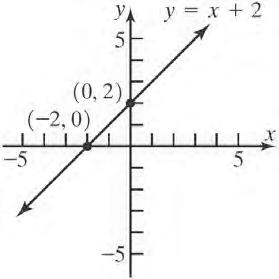
20. 6 yx x-intercept: y-intercept:
The intercepts are 6,0 and 0,6
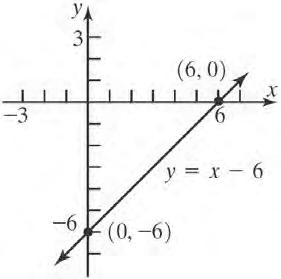
21. 28yx x-intercept: y-intercept: 028 28 4 x
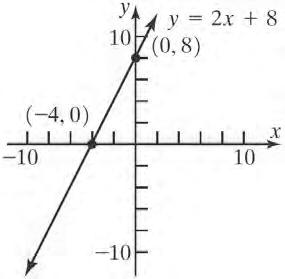
22. 39yx x-intercept: y-intercept: 039 39 3 x
The intercepts are 3,0 and

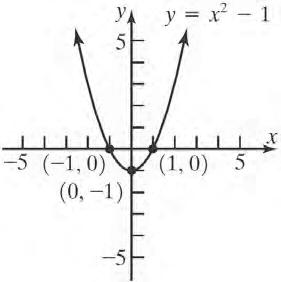
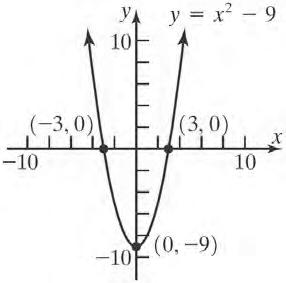
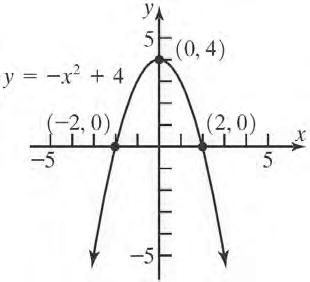
26. 2 1 yx
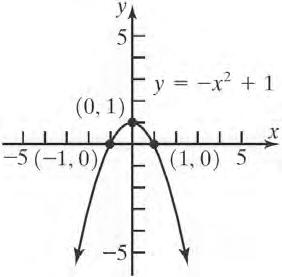

28. 5210 xy
x-intercepts: y-intercept:
52010 510 2 x x x
The intercepts are 2,0 and 0,5

29. 2 9436 xy
x-intercepts: y-intercept:
2 2 2 94036 936 4 2 x x x x
intercepts
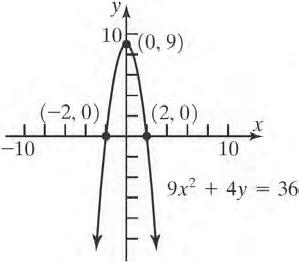
30. 2 44 xy
x-intercepts: y-intercept: 2 2 2 404 44 1 1 x x x x
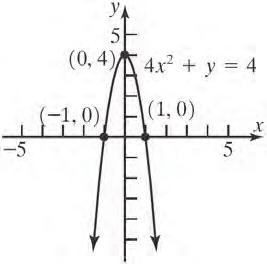

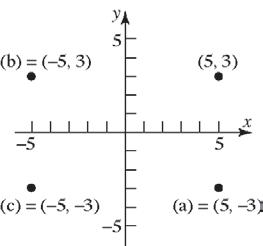
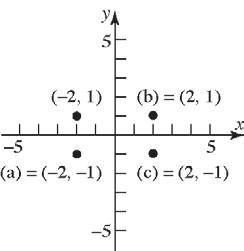

= (5, 2) (c) = (5, 2)
= (5, 2)


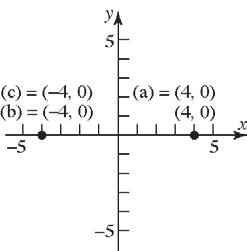

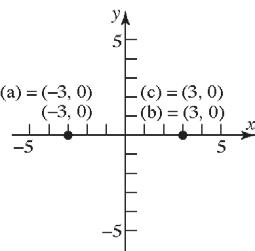
41. a. Intercepts: 1,0 and 1,0
b. Symmetric with respect to the x-axis, y-axis, and the origin.
42. a. Intercepts: 0,1
b. Not symmetric to the x-axis, the y-axis, nor the origin
43. a. Intercepts: 2 0 , , 0,1 , and 2 ,0
b. Symmetric with respect to the y-axis.
44. a. Intercepts: 2,0 , 0,3 , and 2,0
b. Symmetric with respect to the y-axis.
45. a. Intercepts: 0,0
b. Symmetric with respect to the x-axis.
46. a. Intercepts: 2,0, 0,2, 0,2, and 2,0
b. Symmetric with respect to the x-axis, y-axis, and the origin.
47. a. Intercepts: 2,0 , 0,0 , and 2,0
b. Symmetric with respect to the origin.
48. a. Intercepts: 4,0 , 0,0 , and 4,0
b. Symmetric with respect to the origin.
Graphs
49. a. x-intercepts: 2,1 , y-intercept 0
b. Not symmetric to x-axis, y-axis, or origin.
50. a. x-intercepts: 1,2 , y-intercept 0
b. Not symmetric to x-axis, y-axis, or origin.
51. a. Intercepts: none
b. Symmetric with respect to the origin.
52. a. Intercepts: none
b. Symmetric with respect to the x-axis.
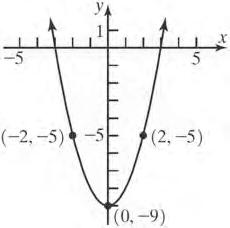

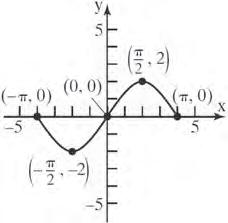

57. 2 16 yx x-intercepts: y-intercepts: 2 016 16 x x 2 2 016 16 4 y y y
The intercepts are 16,0 , 0,4 and 0,4 .
Test x-axis symmetry: Let yy
2 2 16 16 same yx yx
Test y-axis symmetry: Let x x 2 16 yx different
Test origin symmetry: Let x x and yy
2 2 16 16 different
yx yx
Therefore, the graph will have x-axis symmetry.
58. 2 9 yx
x-intercepts: y-intercepts: 2 (0)9 09 9 x x x 2 2 09 9 3 y y y
The intercepts are 9,0 , 0,3 and 0,3 .
Test x-axis symmetry: Let yy
2 2 9 9 same yx yx
Test y-axis symmetry: Let x x 2 9 yx different
Test origin symmetry: Let x x and yy
2 2 9 9 different yx yx
Therefore, the graph will have x-axis symmetry.
59. 3 y x
x-intercepts: y-intercepts: 3 0 0 x x 3 00 y
The only intercept is 0,0 .
Test x-axis symmetry: Let yy 3 different yx
Section1.2: Graphs of Equations in Two Variables; Intercepts; Symmetry
Test y-axis symmetry: Let x x 33 different yxx
Test origin symmetry: Let x x and yy 33 3 same y xx yx
Therefore, the graph will have origin symmetry.
60. 5 y x
x-intercepts: y-intercepts: 3 0 0 x x
The only intercept is 0,0
Test x-axis symmetry: Let yy 5 different yx
Test y-axis symmetry: Let x x 55 different yxx
Test origin symmetry: Let x x and yy
55 5 same y xx yx
Therefore, the is symmetric with respect to the origin.
61. 2 90 xy
x-intercepts: y-intercepts: 2 2 90 9 3 x x x
2 090 9 y y
The intercepts are 3,0 , 3,0 , and 0,9 .
Test x-axis symmetry: Let yy
2 90 different xy
Test y-axis symmetry: Let x x
2 2 90 90 same xy xy
Test origin symmetry: Let x x and yy
2 2 90 90 different xy xy
Therefore, the graph has y-axis symmetry.
62. 2 40 xy
The intercepts are 2,0 , 2,0 , and 0,4
Test x-axis symmetry: Let yy
2 2 40 40 different xy xy
Test y-axis symmetry: Let x x
2 2 40 40 same xy xy
Test origin symmetry: Let x x and yy
2 2 40 40 different xy xy
Therefore, the graph has y-axis symmetry.
63. 22 254100 xy
x-intercepts: y-intercepts: 2 2 2 2 2540100 25100 4 2
x x x x
The intercepts are 2,0 , 2,0, 0,5, and 0,5 .
Test x-axis symmetry: Let yy 2 2 22 254100 254100 same
xy xy
Test y-axis symmetry: Let x x 2 2 22 254100 254100 same xy xy
Test origin symmetry: Let x x and yy
22 22 254100 254100 same
xy xy
Therefore, the graph has x-axis, y-axis, and origin symmetry.
64. 22 44 xy x-intercepts: y-intercepts:
22 2 2 404 44 1 1 x x x x
2 2 2 404 4 2 y y y
The intercepts are 1,0 , 1,0 , 0,2 , and
0,2 .
Test x-axis symmetry: Let yy
2 2 22 44 44 same xy xy
Test y-axis symmetry: Let x x
2 2 22 44 44 same xy xy
Test origin symmetry: Let x x and yy
22 22 44 44 same xy xy
Therefore, the graph has x-axis, y-axis, and origin symmetry.
65. 3 64 yx x-intercepts: y-intercepts: 3 3 064 64 4
The intercepts are 4,0 and 0,64
Test x-axis symmetry: Let yy 3 64 different yx
Test y-axis symmetry: Let x x
yx yx
3 3 64 64 different
Test origin symmetry: Let x x and yy
yx yx
3 3 64 64 different
Therefore, the graph has no symmetry.
66. 4 1 yx
x-intercepts: y-intercepts: 4 4 01 1 1 x x x
4 01 1 y y
The intercepts are 1,0 , 1,0 , and 0,1
Test x-axis symmetry: Let yy 4 1 different yx
Test y-axis symmetry: Let x x
4 4 1 1 same yx yx
Test origin symmetry: Let x x and yy
4 4 1 1 different yx yx
Therefore, the graph has y-axis symmetry.
67. 2 28 y xx
x-intercepts: y-intercepts:
2 028 042 4 or 2
y y
xx xx x x 2 0208 8
The intercepts are 4,0 , 2,0 , and 0,8
Test x-axis symmetry: Let yy 2 28 different yxx
Test y-axis symmetry: Let x x 2 2 28 28 different
yxx yxx
Test origin symmetry: Let x x and yy 2 2 28 28 different
yxx yxx
Therefore, the graph has no symmetry.
68. 2 4 yx
x-intercepts: y-intercepts: 2 2 04 4 no real solution x x 2 04 4 y y
The only intercept is 0,4 .
Test x-axis symmetry: Let yy 2 4 different yx
Section1.2: Graphs of Equations in Two Variables; Intercepts; Symmetry
Test y-axis symmetry: Let x x
2 2 4 4 same yx yx
Test origin symmetry: Let x x and yy
2 2 4 4 different yx yx
Therefore, the graph has y-axis symmetry.
69. 2 4 16 x y x x-intercepts: y-intercepts: 2 4 0 16 40 0
x x x x
2 40 0 0 16 016
The only intercept is 0,0
Test x-axis symmetry: Let yy 2 4 different 16
x y x
Test y-axis symmetry: Let x x
2
x y x x y x x y x
2 2 2 4 16 4 16 4 same 16
Therefore, the graph has origin symmetry.
70. 2
The intercepts are 2,0 and 2,0 .
Test x-axis symmetry: Let yy 2 4 different 2 x y x
Test y-axis
Therefore, the graph has origin symmetry.
The only intercept is 0,0 .
x-axis
Let yy
Test y-axis symmetry: Let x x
Chapter1: Graphs
Test
Therefore, the graph has origin symmetry.

no real solution
There are no intercepts for the graph of this equation.
Test x-axis symmetry: Let yy
Test y-axis symmetry: Let
Therefore, the graph has origin symmetry.


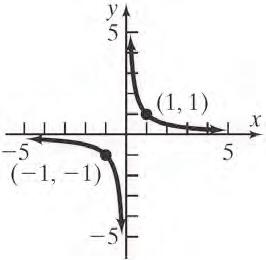
77. If the point ,4 a is on the graph of 2 3 y xx , then we have
2 2 43 034 041 aa aa aa
4 a a
or 10 1 a a
Thus, 4 a or 1 a
78. If the point ,5 a is on the graph of 2 6 y xx , then we have
2 2 56 065 051 aa aa aa
5 a a
or 10 1 a a
Thus, 5 a or 1 a
79. For a graph with origin symmetry, if the point , ab is on the graph, then so is the point , ab . Since the point 1,2 is on the graph of an equation with origin symmetry, the point 1,2 must also be on the graph.
80. For a graph with y-axis symmetry, if the point , ab is on the graph, then so is the point
, ab . Since 6 is an x-intercept in this case, the point 6,0 is on the graph of the equation. Due to the y-axis symmetry, the point 6,0 must also be on the graph. Therefore, 6 is another xintercept.
81. For a graph with origin symmetry, if the point , ab is on the graph, then so is the point , ab . Since 4 is an x-intercept in this case, the point 4,0 is on the graph of the equation. Due to the origin symmetry, the point 4,0 must also be on the graph. Therefore, 4 is another x-intercept.
82. For a graph with x-axis symmetry, if the point , ab is on the graph, then so is the point
, ab . Since 2 is a y-intercept in this case, the point 0,2 is on the graph of the equation. Due to the x-axis symmetry, the point 0,2 must also be on the graph. Therefore, 2 is another yintercept.
83. a. 2 2222 x yxxy
x-intercepts:
2 2222 2 22 4322 43 3 00 2 20 20 xxx xxx xxxx xx xx
3 0or20 02 xx xx
y-intercepts:
2 2222 2 22 42 42 22 000 0 10 yy yy yy yy yy
22 2 0or10 0 1 1 yy y y y
The intercepts are 0,0, 2,0, 0,1, and 0,1
b. Test x-axis symmetry: Let yy
2 2222 2 2222 same xyxxy xyxxy
Test y-axis symmetry: Let x x
2 2222 2 2222 different xyxxy xyxxy
Chapter1: Graphs
Test origin symmetry: Let x x and yy
Thus, the graph will have x-axis symmetry.
84. a. 2 16120225 yx y-intercepts:
2 2 2 161200225 16225 225 16 no real solution y y y
x-intercepts:
2 160120225 0120225 120225 22515 1208 x x x x
The only intercept is 15 ,0 8
b. Test x-axis symmetry: Let yy
2 2 16120225 16120225 same yx yx
Test y-axis symmetry: Let x x
2 2 16120225 16120225 different yx yx
Test origin symmetry: Let x x and yy
2 2 16120225 16120225 different yx yx
Thus, the graph has x-axis symmetry.
85. Let y = 0. 222222 422 422 222 222 22 (0)(0) () 0 ()0 0 or ()0 0 or ,
xax xax xax xxa xxa xxa xaa
Let x = 0. 222222 422 422 222 (0)(0) () 0 ()0 0
yay yay yay yya y
(Note that the solutions to 22 0 ya are not real)
So the intercepts are are (0,0), (a,0) and (-a,0).
Test x-axis symmetry: Replace y by -y 222222 222222 (())(()) ()() equivalent
xyaxy xyaxy
Test y-axis symmetry: replace x by -x 222222 222222 (())(()) ()() equivalent
xyaxy xyaxy
Test origin symmetry: replace x by -x and y by -y 222222 222222 (()())(()()) ()() equivalent
x yaxy xyaxy
The graph is symmetric by respect to the xaxis, the y-axis, and the origin.
86. Let y = 0. 222222 432222 2 (0)(0) 20 (()(()0 0 or or
xaxbx xaxaxbx xxabxab x xab xab
Let x = 0. 222222 422 2 (00)(0) 0 ()()0 0,,
yaby yby yybyb yybyb
So the intercepts are (0,0), (a-b,0), (a+b,0), (0,-b), (0, b).
Test x-axis symmetry: replace y by -y 2 22222 222222 () () ()() Equivalent xyaxbxy xyaxbxy
87. a.
Section1.2: Graphs of Equations in Two Variables; Intercepts; Symmetry
Test y-axis symmetry: replace x by -x 2
()() Not equivalent
Test origin symmetry: replace x by -x and y by -y
()() No equivalent
The graph is symmetric with respect to the x-axis only.
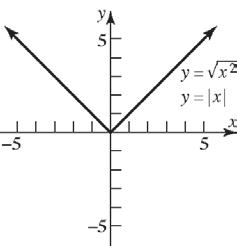
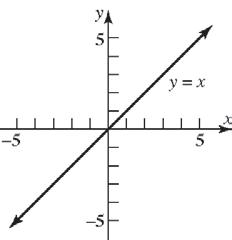

b. Since 2 x x for all x , the graphs of 2 and yxyx are the same.
c. For 2 yx , the domain of the variable x is 0 x ; for yx , the domain of the
variable x is all real numbers. Thus, 2 only for 0. xxx
d. For 2 yx , the range of the variable y is 0 y ; for yx , the range of the variable y is all real numbers. Also, 2 x x only if 0 x . Otherwise, 2 x x .
88. Answers will vary. A complete graph presents enough of the graph to the viewer so they can “see” the rest of the graph as an obvious continuation of what is shown.
89. Answers will vary. One example: y x
90. Answers will vary
91. Answers will vary
92. Answers will vary.
Case 1: Graph has x-axis and y-axis symmetry, show origin symmetry.
, on graph, on graph (from -axis symmetry) xyxy x
, on graph, on graph from -axis symmetry xy xy y
Since the point , x y is also on the graph, the graph has origin symmetry.
Case 2: Graph has x-axis and origin symmetry, show y-axis symmetry.
, on graph, on graph from -axis symmetry xy xy x
, on graph, on graph from origin symmetry xy xy
Since the point , x y is also on the graph, the graph has y-axis symmetry.
Case 3: Graph has y-axis and origin symmetry, show x-axis symmetry.
, on graph, on graph from -axis symmetry xy xy y
, on graph, on graph from origin symmetry xy xy
Since the point , x y is also on the graph, the graph has x-axis symmetry.
93. Answers may vary. The graph must contain the points 2,5 , 1,3 , and 0,2 . For the graph to be symmetric about the y-axis, the graph must also contain the points 2,5 and 1,3 (note that (0, 2) is on the y-axis).
For the graph to also be symmetric with respect to the x-axis, the graph must also contain the points 2,5 , 1,3 , 0,2 , 2,5 , and 1,3 . Recall that a graph with two of the symmetries (x-axis, y-axis, origin) will necessarily have the third. Therefore, if the original graph with y-axis symmetry also has xaxis symmetry, then it will also have origin symmetry.
Section 1.3
1. undefined; 0
2. 3; 2 x-intercept: 23(0)6 26 3 x x x
intercept: 2(0)36
3. True
4. False; the slope is 3 2
5. True;
? ? 2124
6. 12mm ; y-intercepts; 12 1 mm
b
d
13. a. 101 Slope 202
b. If x increases by 2 units, y will increase by 1 unit.
14. a. 101 Slope 202
b. If x increases by 2 units, y will decrease by 1 unit.
15. a. 121 Slope 1(2)3
b. If x increases by 3 units, y will decrease by 1 unit.
16. a. 211 Slope 2(1)3
b. If x increases by 3 units, y will increase by 1 unit.
17. 21 21 033 Slope 422 yy xx

18. 21 21 422 Slope2 341 yy xx
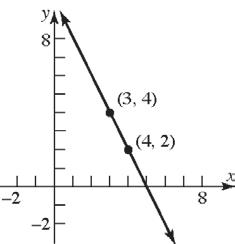
19. 21 21 1321 Slope 2(2)42 yy xx
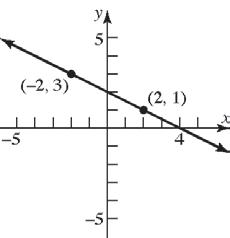
20. 21 21 312 Slope 2(1)3 yy xx
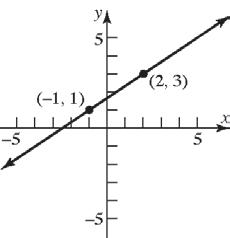
21. 21 21 1(1)0 Slope0 2(3)5 yy xx
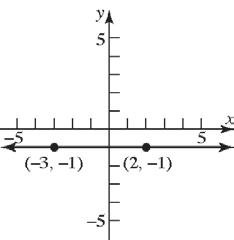
22. 21 21 220 Slope0 549 yy xx
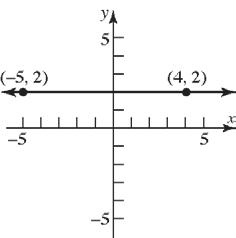
23. 21 21 224 Slope undefined. 1(1)0 yy xx

24. 21 21 202 Slope undefined. 220 yy xx
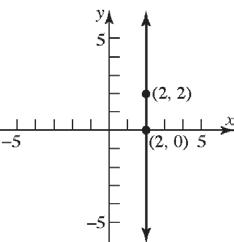
Chapter1: Graphs
1,2;3Pm
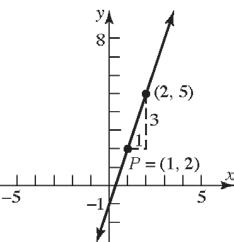
2,1;4Pm
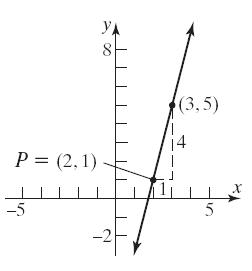
27. 3 2,4; 4 Pm 28. 2 1,3; 5 Pm

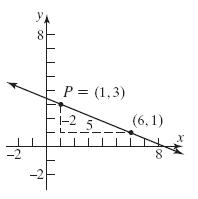
1,3;0Pm
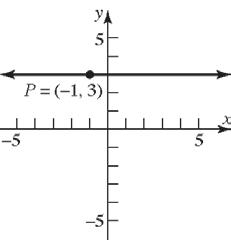
2,4;0Pm
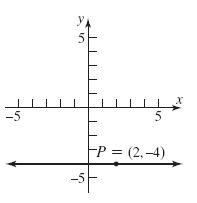
31. 0,3; slope undefined P
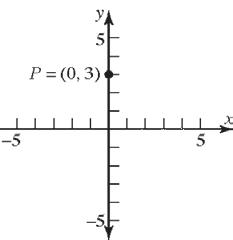
(note: the line is the y-axis)
32. 2,0; slope undefined P
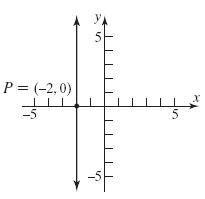
33. 1,2;3Pm ; 23(1)yx
34. 2,1;4Pm ; 14(2)yx
35. 3 2,4; 4 Pm ; 3 4(2) 4 yx
36. 2 1,3; 5 Pm ; 2 3(1) 5 yx
37. 1,3;0Pm ; 30 y
38. 2,4;0Pm ; 40 y
39. 4 Slope4 1 ; point: 1,2
If x increases by 1 unit, then y increases by 4 units.
Answers will vary. Three possible points are:
112 and 246 2,6 213 and 6410 3,10 314 and 10414 4,14 xy xy xy
40. 2 Slope2 1 ; point: 2,3
If x increases by 1 unit, then y increases by 2 units.
Answers will vary. Three possible points are:
211 and 325 1,5 110 and 527 0,7 011 and 729 1,9 xy xy xy
41. 33 Slope 22 ; point: 2,4
If x increases by 2 units, then y decreases by 3 units.
Answers will vary. Three possible points are: 224 and 437 4,7 426 and 7310 6,10 628 and 10313 8,13 xy xy xy
42. 4 Slope 3 ; point: 3,2
If x increases by 3 units, then y increases by 4 units.
Answers will vary. Three possible points are:
330 and 246 0,6 033 and 6410 3,10 336 and 10414 6,14 xy xy xy
43. 2 Slope2 1 ; point: 2,3
If x increases by 1 unit, then y decreases by 2 units.
Answers will vary. Three possible points are:
211 and 325 1,5 110 and 527 0,7 011 and 729 1,9 xy xy xy
44. 1 Slope1 1 ; point: 4,1
If x increases by 1 unit, then y decreases by 1 unit.
Answers will vary. Three possible points are:
415 and 110 5,0 516 and 011 6,1 617 and 112 7,2 xy xy xy
Chapter1: Graphs
45. (0, 0) and (2, 1) are points on the line.
101
Slope 202
-intercept is 0; using : yymxb
1 0 2 2 02 1 20 or 2 yx yx xy x yyx
46. (0, 0) and (–2, 1) are points on the line.
1011
Slope 2022 -intercept is 0; using : yymxb
1 0 2 2 20 1 20 or 2 yx yx xy x yyx
47. (–1, 3) and (1, 1) are points on the line. 11 132 Slope1 1(1)2
Using ()yymxx
11(1) 11 2 2 or 2 yx yx yx xyyx
48. (–1, 1) and (2, 2) are points on the line. 11 211 Slope 2(1)3
Using ()yymxx
1 1(1) 3 1 1(1) 3 11 1 33 14 33 14 34 or 33 yx yx yx yx xyyx
49. 11(),2yymxxm 32(3) 326 23 23 or 23 yx yx yx xyyx
50. 11(),1yymxxm 21(1) 21 3 3 or 3 yx yx yx xyyx
51. 11 1 (), 2 yymxxm 1 2(1) 2 11 2 22 15 22 15 25 or 22 yx yx yx xyyx
52. 11(),1yymxxm 11((1)) 11 2 2 or 2 yx yx yx xyyx
53. Slope = 3; containing (–2, 3) 11() 33((2)) 336 39 39 or 39 yymxx yx yx yx xyyx
54. Slope = 2; containing the point (4, –3) 11() (3)2(4) 328 211 211 or 211 yymxx yx yx yx xyyx
55. Slope = 1 2 ; containing the point (3, 1) 11() 1 1(3) 2 13 1 22 11 22 11 21 or 22 yymxx yx yx yx xyyx
56. Slope = 2 3 ; containing (1, –1) 11() 2 (1)(1) 3 22 1 33 21 33 21 231 or 33 yymxx yx yx yx xyyx
57. Containing (1, 3) and (–1, 2) 2311 1122 m 11() 1 3(1) 2 11 3 22 15 22 15 25 or 22 yymxx yx yx yx xyyx
58. Containing the points (–3, 4) and (2, 5) 541 2(3)5 m
11() 1 5(2) 5 12 5 55 123 55 123 523 or 55 yymxx yx yx yx xyyx
59. Slope = –3; y-intercept =3 33 33 or 33 ymxb yx xyyx
60. Slope = –2; y-intercept = –2 2(2) 22 or 22 ymxb yx xyyx
61. x-intercept = –4; y-intercept = 4 Points are (–4, 0) and (0, 4) 404 1 0(4)4
m 14 4 4 or 4 ymxb yx yx xyyx
62. x-intercept = 2; y-intercept = –1 Points are (2,0) and (0,–1) 1011 0222
m 1 1 2 1 22 or 1 2 ymxb yx x yyx
63. Slope undefined; containing the point (2, 4) This is a vertical line.
2 No slope-intercept form. x
64. Slope undefined; containing the point (3, 8) This is a vertical line.
3 No slope-intercept form. x
65. Horizontal lines have slope 0 m and take the form yb . Therefore, the horizontal line passing through the point 3,2 is 2 y .
66. Vertical lines have an undefined slope and take the form x a . Therefore, the vertical line passing through the point 4,5 is 4 x
67. Parallel to 2 y x ; Slope = 2 Containing (–1, 2) 11() 22((1)) 22224 24 or 24 yymxx yx yxyx xyyx
68. Parallel to 3 y x ; Slope = –3; Containing the point (–1, 2) 11() 23((1)) 23331 31 or 31 yymxx yx yxyx xyyx
69. Parallel to 25xy ; 1 Slope; Containing the point 0,0 2 11() 11 0(0)22 1 20 or 2 yymxx yxyx xyyx
70. Parallel to 22 xy
; Slope = 2
Containing the point (0, 0) 11() 02(0) 2 20 or 2 yymxx yx yx x yyx
71. Parallel to 5 x ; Containing (4,2)
This is a vertical line.
4 No slope-intercept form. x
72. Parallel to 5 y ; Containing the point (4, 2) This is a horizontal line. Slope = 0 2 y
73. Perpendicular to 1 4; 2 yx Containing (1, –2)
Slope of perpendicular = –2 11() (2)2(1) 2222 20 or 2 yymxx yx yxyx xyyx
74. Perpendicular to 23yx ; Containing the point (1, –2) 1
Slope of perpendicular 2 11() 1 (2)(1) 2 1113 2 2222 13 23 or 22 yymxx yx yxyx xyyx
75. Perpendicular to 25xy ; Containing the point (0, 4) Slope of perpendicular = –2 24 24 or 24 ymxb yx xyyx
76. Perpendicular to 22 xy ; Containing the point (–3, 0) 1 Slope of perpendicular 2 11() 113 0((3))22 2 13 23 or 22 yymxx yxyx xyyx
77. Perpendicular to 8 x ; Containing (3, 4) Slope of perpendicular = 0 (horizontal line) 4 y
78. Perpendicular to 8 y ; Containing the point (3, 4)
Slope of perpendicular is undefined (vertical line). 3 x No slope-intercept form.
79. 23yx ; Slope = 2; y-intercept = 3
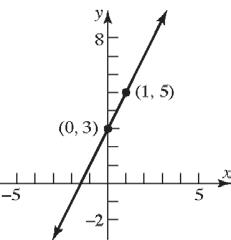
80. 34yx ; Slope = –3; y-intercept = 4
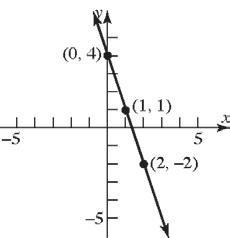
81. 1 1 2 yx ; 22yx Slope = 2; y-intercept = –2 82. 1 2 3 xy ; 1 2 3 yx 1 Slope 3 ; y-intercept = 2 83. 1 2 2 yx ; 1 Slope 2 ; y-intercept = 2 84. 1 2 2 yx ; Slope = 2; 1 -intercept 2 y
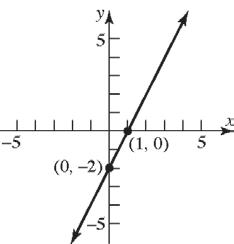
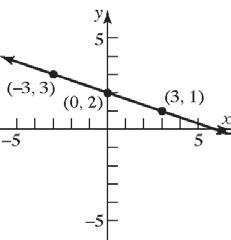
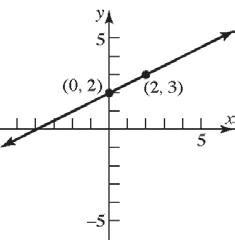
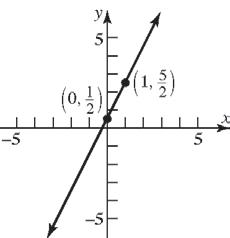
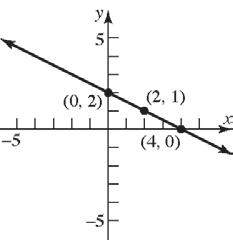
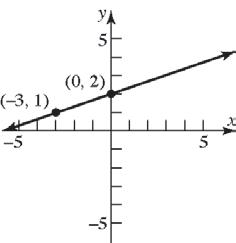

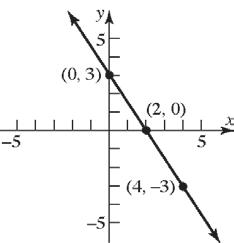


91. 4 x ; Slope is undefined y-intercept - none


92. 1 y ; Slope = 0; y-intercept = –1

93. 5 y ; Slope = 0; y-intercept = 5
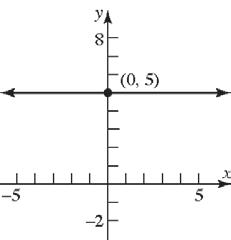
94. 2 x ; Slope is undefined y-intercept - none
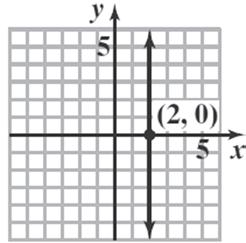
95. 0 yx ; yx
Slope = 1; y-intercept = 0

96. 0 xy ; yx
Slope = –1; y-intercept = 0

97. 230 yx ; 3 23 2 yxyx 3 Slope 2 ; y-intercept = 0

98. 320 xy ; 3 23 2 yxyx 3 Slope 2 ; y-intercept = 0 99. a. x-intercept: 2306
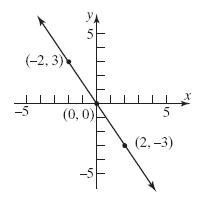
The point 3,0 is on the graph.
The
100. a. x-intercept:
The point 2,0 is on the graph. y-intercept: 3026
The point 0,3 is on the graph. b.
101. a. x-intercept:
45040
The point 10,0 is on the graph. y-intercept: 40540 540 8 y y y
The point 0,8 is on the graph.
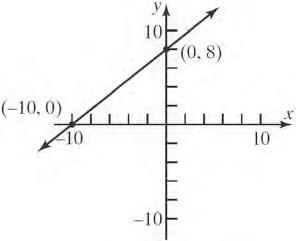
102. a. x-intercept: 64024 624 4 x x x
The point 4,0 is on the graph.
y-intercept: 60424 424 6 y y y
The point 0,6 is on the graph.
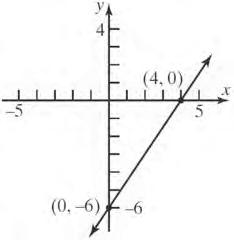
103. a. x-intercept: 72021 721 3 x x x
The point 3,0 is on the graph.
y-intercept: 70221 221 21 2 y y y
The point 21 0, 2 is on the graph.
b.

104. a. x-intercept: 53018 518 18 5 x x x
The point 18 ,0 5 is on the graph.
y-intercept: 50318 318 6 y y y
The point 0,6 is on the graph. b.
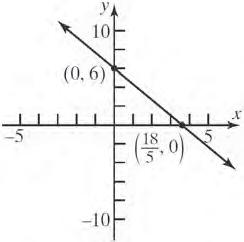
105. a. x-intercept: 11 01 23 1 1 2 2 x x x
The point 2,0 is on the graph.
y-intercept: 11 01 23 1 1 3 3 y y y
The point 0,3 is on the graph.
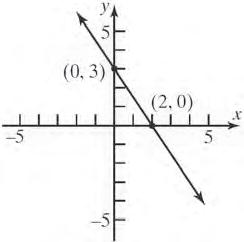
106. a. x-intercept: 2 04 3 4 x x
The point 4,0 is on the graph.
y-intercept: 2 04 3 2 4 3 6 y y y
The point 0,6 is on the graph.
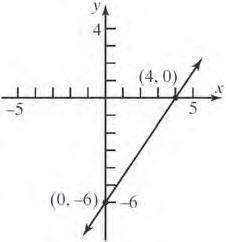
107. a. x-intercept: 0.20.501 0.21 5 x x x
The point 5,0 is on the graph.
y-intercept: 0.200.51 0.51 2 y y y
The point 0,2 is on the graph.

108. a. x-intercept: 0.30.401.2 0.31.2 4 x x x
The point 4,0 is on the graph. y-intercept: 0.300.41.2
The point 0,3 is on the graph.
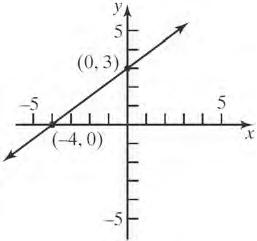
109. The equation of the x-axis is 0 y . (The slope is 0 and the y-intercept is 0.)
110. The equation of the y-axis is 0 x . (The slope is undefined.)
111. The slopes are the same but the y-intercepts are different. Therefore, the two lines are parallel.
112. The slopes are opposite-reciprocals. That is, their product is 1 . Therefore, the lines are perpendicular.
113. The slopes are different and their product does not equal 1 . Therefore, the lines are neither parallel nor perpendicular.
114. The slopes are different and their product does not equal 1 (in fact, the signs are the same so the product is positive). Therefore, the lines are neither parallel nor perpendicular.
115. Intercepts: 0,2 and 2,0 . Thus, slope = 1. 2 or 2 yxxy
116. Intercepts: 0,1 and 1,0 . Thus, slope = –1. 1 or 1 yxxy
117. Intercepts: 3,0 and 0,1 . Thus, slope = 1 3 1 1 or 33 3 yxxy
118. Intercepts: 0,1 and 2,0 . Thus, slope = 1 2 1 1 or 22 2 yxxy 119. 1 2,5 P , 2 1,3 P : 1 5322 2133 m 2 1,3 P , 3 1,0 P :
Since 12 1 mm , the line segments 12PP and 23PP are perpendicular. Thus, the points 1P , 2P , and 3P are vertices of a right triangle.
120. 1 1,1 P , 2 4,1 P , 3 2,2 P
13 21 3 21 m
Each pair of opposite sides are parallel (same slope) and adjacent sides are not perpendicular. Therefore, the vertices are for a parallelogram.
121. 1 1,0 P , 2 2,3 P , 3 1,2 P ,
4 4,1 P
12 303 1 213 m
; 24 13 1 42 m ;
34 12 3 1 413 m ; 13 20 1 11 m
Opposite sides are parallel (same slope) and adjacent sides are perpendicular (product of slopes is 1 ). Therefore, the vertices are for a rectangle.
22 12 10301910 d 22 23 41239110 d
22 34 34121910 d 22 14 30109110 d
Opposite sides are parallel (same slope) and adjacent sides are perpendicular (product of slopes is 1 ). In addition, the length of all four sides is the same. Therefore, the vertices are for a square.
123. Let x = number of miles driven, and let C = cost in dollars.
Total cost = (cost per mile)(number of miles) + fixed cost 0.6039Cx
When x = 110, 0.6011039$105.00 C
When x = 230, 0.6023039$177.00 C
124. Let x = number of pairs of jeans manufactured, and let C = cost in dollars.
Total cost = (cost per pair)(number of pairs) + fixed cost 201200Cx
When x = 400, 204001200$9200 C .
When x = 740, 207401200$16,000 C
125. Let x = number of miles driven annually, and let C = cost in dollars.
Total cost = (approx cost per mile)(number of miles) + fixed cost 0.286578Cx
126. Let x = profit in dollars, and let S = salary in dollars.
Weekly salary = (% share of profit)(profit) + weekly pay 0.05525Sx
127. a. 0.1317Cx ; 01000 x b.

c. For 50 miles, 0.135017$23.50 C
d. For 120 miles, 0.1312017$32.60 C
e. For every 1-mile in distance traveled, the cost will increase 13 cents.
128. a. 600.25 Cx b.
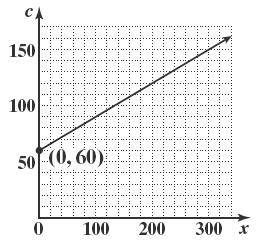
c. For 20 minutes, 600.2520$65.00 C
d. For 60 minutes, 600.2560$75.00 C
e. For every 1-minute increase in international calls the cost will increase by $0.25 (that is, 25 cents).
129. (,)(0,32);(,)(100,212) CF CF 212321809 slope 10001005 9 32(0) 5 9 32() 5 5 (32) 9 FC FC CF
If 70 F , then 55 99(7032)(38) 21.1 C C
130. a. º273KC
b. 5 º(º32) 9 CF 5 (32)273 9 5160 º273 99 52297 º 99 KF KF KF
131. a. The y-intercept is (0, 30), so b = 30. Since the ramp drops 2 inches for every 25 inches of run, the slope is 22 2525 m . Thus, the equation is 2 30 25 yx .
b. Let y = 0. 2 030 25 2 30 25 25225 30 2252 375 x x
The x-intercept is (375, 0). This means that the ramp meets the floor 375 inches (or 31.25 feet) from the base of the platform.
c. No. From part (b), the run is 31.25 feet which exceeds the required maximum of 30 feet.
d. First, design requirements state that the maximum slope is a drop of 1 inch for each 12 inches of run. This means 1 12 m
Second, the run is restricted to be no more than 30 feet = 360 inches. For a rise of 30 inches, this means the minimum slope is 301 36012 . That is, 1 12 m . Thus, the only possible slope is 1 12 m . The diagram indicates that the slope is negative. Therefore, the only slope that can be used to obtain the 30-inch rise and still meet design requirements is 1 12 m . In words, for every 12 inches of run, the ramp must drop exactly 1 inch.
132. a. Let x represent the percent of internet ad spending. Let y represent the percent of print ad spending. Then the points (0.19, 0.26) and (0.35, 0.16) are on the line. Thus, 162610 0.625 351916
m . Using the point-slope formula we have 260.625(19) 260.62511.875 0.62537.875
yx yx yx
b. x-intercept: 00.62537.875 37.8750.625
60.6 x x x
y-intercept: 0.625(0)37.875 37.875 y
The intercepts are (60.6, 0) and (0, 37.875).
c y-intercept: When Internet ads account for 0% of U.S. advertisement spending, print ads account for 37.875% of the spending. x-intercept: When Internet ads account for 60.6% of U.S. advertisement spending, print ads account for 0% of the spending.
d. Let x = 39.2. 0.625(39.2)37.87513.4% y
133. a. Let x = number of boxes to be sold, and A = money, in dollars, spent on advertising. We have the points 11 (,)(100,000,40,000); xA
22 (,)(200,000,60,000) xA
60,00040,000 slope 200,000100,000 20,0001 100,0005 1 40,000100,000 5 1 40,00020,000 5 1 20,000 5 Ax Ax Ax
b. If x = 300,000, then
c. Each additional box sold requires an additional $0.20 in advertising.
134. 2 x yC
Graph the lines: 24 20 22 xy xy xy
All the lines have the same slope, 2. The lines are parallel.

135. Put each linear equation in slope/intercept form. 25
If the slope of yax equals the slope of either of the other two lines, then no triangle is formed.
So, 11 22 aa and 22 33
aa
Also if all three lines intersect at a single point,
xx x x
then no triangle is formed. So, we find where 1524 and 2233 yxyx intersect. 1524 2233 77 66 1 15 22(1)2
The two lines intersect at (1, 2). If yax also contains the point (1, 2), then 212 aa
The three numbers are 12 ,, and -2. 23
136. The slope of the line containing , ab and , ba is 1 ab ba
The slope of the line yx is 1.
The two lines are perpendicular. The midpoint of (,) and (,)abba is , 22 abba M
Since the x and y coordinates of M are equal, M lies on the line yx
Note: 22 abba
137. The three midpoints are 000 0 ,,0,,, 2222222
aaabcabc and 00 ,, 2222
bcbc
1 1 from (0,0) to , 22 0 2 ; 0 2 0(0)
c yx ab c yx ab 2 from (a, 0) to , 22
bc Line cc c m bba ba a c yxa ba c yxa ba 3 from ,0 to (,) 2 02 2 2 2 0 22 2
cc x xa abba ba xxa ab baab xa ab a xa ab ab x
a Linebc cc m a ba b ca yx ba ca yx ba Find where line 1 and line 2 intersect: () 2 2 2 3 ; 3
Substitute into line 1:
cabc y ab
abc
So, line 1 and line 2 intersect at 33,.
Show that line 3 contains the point , 33
abc : 22 2 232263
cabacbac y ba ba So the three lines intersect at 33,. abc
138. Refer to Figure 47. Assume 12 1 mm . Then
2 22 12 2 12 22 1122 22 12 22 12 (,)(11)() () 2 2(1) 2
dABmm mm mmmm mm mm
Now, 2 222 11 2 222 22 (,)(10)(0)1 (,)(10)(0)1 dOBmm dOA mm , So
dOBdOAmm mmdAB
22 22 12 2 22 12 (,)(,)11 2(,)
By the converse of the Pythagorean Theorem, AOB is a right triangle with right angle at vertex O. Thus lines OA and OB are perpendicular.
139. (b), (c), (e) and (g)
The line has positive slope and positive y-intercept.
140. (a), (c), and (g)
The line has negative slope and positive y-intercept.
141. (c)
The equation 2 xy has slope 1 and yintercept (0,2). The equation 1 xy has slope 1 and y-intercept (0,1). Thus, the lines are parallel with positive slopes. One line has a positive y-intercept and the other with a negative y-intercept.
142. (d)
The equation 22yx has slope 2 and yintercept (0,2). The equation 21xy has slope 1 2 and y-intercept 1 0,. 2 The lines are perpendicular since 1 21 2
. One line has a positive y-intercept and the other with a negative y-intercept.
143 – 145. Answers will vary.
146. No, the equation of a vertical line cannot be written in slope-intercept form because the slope is undefined.
147. No, a line does not need to have both an xintercept and a y-intercept. Vertical and horizontal lines have only one intercept (unless they are a coordinate axis). Every line must have at least one intercept.
148. Two lines with equal slopes and equal y-intercepts are coinciding lines (i.e. the same).
149. Two lines that have the same x-intercept and yintercept (assuming the x-intercept is not 0) are the same line since a line is uniquely defined by two distinct points.
150. No. Two lines with the same slope and different xintercepts are distinct parallel lines and have no points in common.
Assume Line 1 has equation 1ymxb and Line 2 has equation 2ymxb ,
Line 1 has x-intercept 1b m and y-intercept 1b .
Line 2 has x-intercept 2b m and y-intercept 2b
Assume also that Line 1 and Line 2 have unequal x-intercepts.
If the lines have the same y-intercept, then 12bb .
But 12 bb mm Line 1 and Line 2 have the same x-intercept, which contradicts the original assumption that the lines have unequal x-intercepts. Therefore, Line 1 and Line 2 cannot have the same y-intercept.
151. Yes. Two distinct lines with the same y-intercept, but different slopes, can have the same x-intercept if the x-intercept is 0 x
Assume Line 1 has equation 1 ymxb and Line 2 has equation 2 ymxb ,
Line 1 has x-intercept 1 b m and y-intercept b
Line 2 has x-intercept 2 b m and y-intercept b
Assume also that Line 1 and Line 2 have unequal slopes, that is 12mm .
If the lines have the same x-intercept, then 12 bb mm
12 21 21 0 bb mm mbmb mbmb
2112 1212 But 0 0 0 or 0 mbmbbmm b mmmm
Since we are assuming that 12mm , the only way that the two lines can have the same x-intercept is if 0. b
152. Answers will vary.
153. 21 21 4263 42 13 yy m xx
It appears that the student incorrectly found the slope by switching the direction of one of the subtractions.
Section 1.4
1. add; 2 1 2 1025
2. 2 29 29 23 23 x x x x
5 or 1 xx The solution set is {1,5}.
3. False. For example, 22 2280xyxy is not a circle. It has no real solutions.
4. radius
5. True; 2 93rr
6. False; the center of the circle
22 3213xy is 3,2
7. d
8. a
9. Center = (2, 1)
Radiusdistance from (0,1) to (2,1) (20)(11)42
22
Equation: 22 (2)(1)4 xy
10. Center = (1, 2) 22
Radiusdistance from (1,0) to (1,2) (11)(20)42
Equation: 22 (1)(2)4 xy
11. Center = midpoint of (1, 2) and (4, 2)
1422 5 222,,2
Radiusdistance from ,2 to (4,2) 593 4(22)242
Equation: 2 2 59 (2) 24xy
12. Center = midpoint of (0, 1) and (2, 3)
0213 ,1,2 22
Radiusdistance from 1,2 to (2,3) 21(32)2
2 2
Equation: 2 2 1(2)2xy
13. ()()222 x hykr 222 22 (0)(0)2 4 xy xy
General form: 22 40 xy

14. ()()222 x hykr 222 22 (0)(0)3 9 xy xy
General form: 22 90 xy

15. ()()222 x hykr 222 22 (0)(2)2 (2)4 xy xy
General form: 22 22 444 40 xyy xyy

16. ()()222 x hykr 222 22 (1)(0)3 (1)9 xy xy
General form: 22 22 219 280 xxy xyx

17. ()()222 x hykr 222 22 (4)((3))5 (4)(3)25 xy xy
General form: 22 22 8166925 860 xxyy xyxy
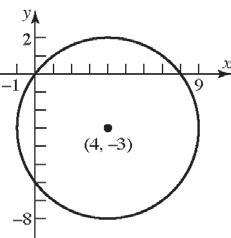
18. ()()222 x hykr 222 22 (2)((3))4 (2)(3)16 xy xy
General form: 22 22 446916 4630 xxyy xyxy
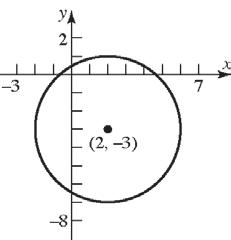
19. ()()222 x hykr 222 22 (2)(1)4 (2)(1)16 xy xy
General form: 22 22 442116 42110 xxyy xyxy
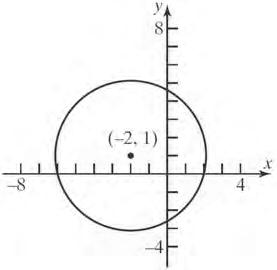
20. ()()222 x hykr
222 22 (5)((2))7 (5)(2)49 xy xy
General form: 22 22 10254449 104200 xxyy xyxy

21. ()()222 x hykr 22 2 2 2 11 (0) 22 11 24 xy xy
General form: 22 22 11 44 0 xxy xyx

22. ()()222 x hykr
2 2 2 2 2 11 0 22 11 24 xy xy
General form: 22 22 11 44 0 xyy xyy
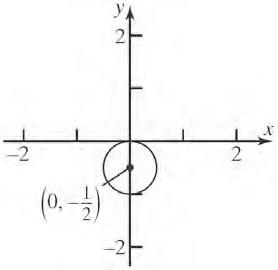
23. ()()222 x hykr
2 22 22 (5)((1))13 (5)(1)13
xy xy
General form: 22 22 10252113 102130
xxyy xyxy
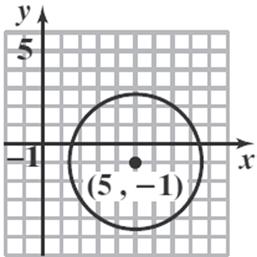
24. ()()222 x hykr
2 22 22 (3)(2)25 (3)(2)20 xy xy
General form: 22 22 694420 6470 xxyy xyxy
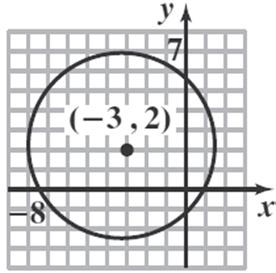
25. 22 4 xy 222 2 xy a. Center: (0,0); Radius2
b.
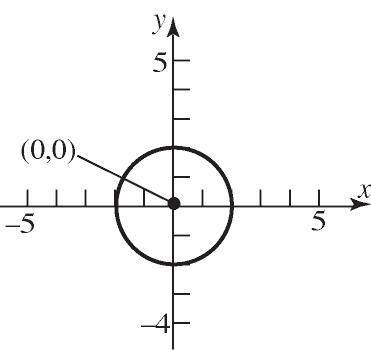
c. x-intercepts: 2 2 2 04 4 42 x x x
y-intercepts:
The intercepts are
26. 22(1)1xy 222 (1)1xy
a. Center:(0,1); Radius1
b.

c. x-intercepts:
2 or 0 yy The intercepts are 0,0 and 0,2.
27. 2 2 2328 xy 2 2 34xy
a. Center: (3, 0); Radius 2
b.
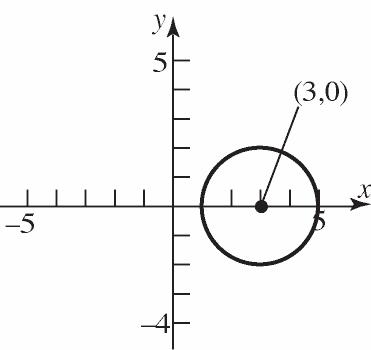
c. x-intercepts:
28. 22 31316 xy
22 112xy
a. Center: (–1,1); Radius = 2 b.
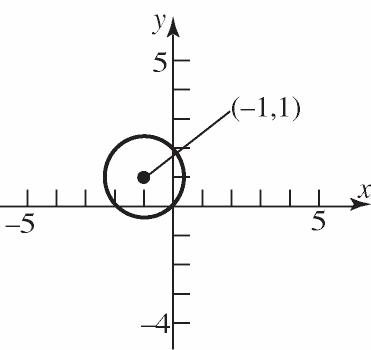
c. x-intercepts:
a. Center: (1, 2); Radius = 3
b.

c. x-intercepts:
y-intercepts:
The intercepts are 15,0,15,0, 0,222, and 0,222. 30. 22 42200xyxy 22 22 222 4220 (44)(21)2041 (2)(1)5 xxyy xxyy xy
a. Center: (–2,–1); Radius = 5 b.
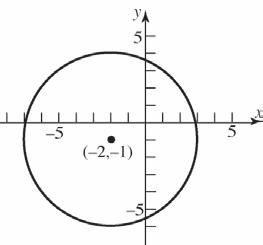
c. x-intercepts: 222 2 2 (2)(01)5 (2)125 (2)24 224 226 226 x x x x x x
y-intercepts: 222 2 2 (02)(1)5 4(1)25 (1)21 121 121 y y y y y
The intercepts are 226,0, 226,0, 0,121, and 0,121.
31. 22 22 22 222 4410 441 (44)(44)144 (2)(2)3 xyxy xxyy xxyy xy
a. Center: (–2, 2); Radius = 3
b. y
c. x-intercepts: 222 2 2 (2)(02)3 (2)49 (2)5 25 25 x x x x x
y-intercepts: 222 2 2 (02)(2)3 4(2)9 (2)5 25 25 y y y y y
The intercepts are 25,0, 25,0,
0,25, and 0,25.
32. 22 22 22 222 6290 629 (69)(21)991 (3)(1)1 xyxy xxyy xxyy xy
a. Center: (3, –1); Radius = 1
b.

c. x-intercepts: 222 2 2 (3)(01)1 (3)11 30 30 3 x x x x x
y-intercepts: 222 2 2 (03)(1)1 9(1)1 18 y y y No real solution. The intercept only intercept is 3,0 . 33. 22 210xyxy 22 22 22 2 21 11 44(21)11 11 (1) 22 xxyy xxyy xy

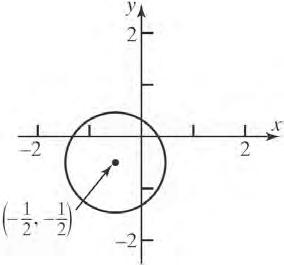
a. Center: (3,–2); Radius = 5 b.
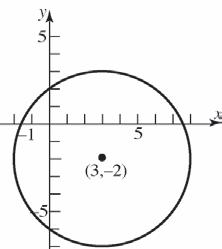
c. x-intercepts: 222 2 2 (3)(02)5 3425 321 321 321 x x x x x
y-intercepts: 222 2 2 (03)(2)5 9225 216 24 24 y y y y y 2 or 6 yy
The intercepts are 321,0, 321,0, 0,6, and 0,2.
36. a. 22 22870 xyx 22 22 22 22 2 22 2827 7 4 2 7 (44)4 2 1 (2) 2 2 (2) 2 xxy xxy xxy xy xy
Center: (–2, 0); Radius = 2 2
b.
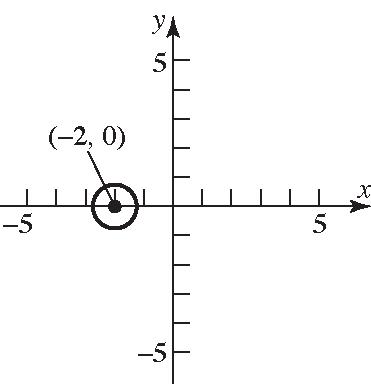
c. x-intercepts:
y-intercepts: 2 22 2 2 022 44 0 0 y y y y The intercepts are 4,0 and
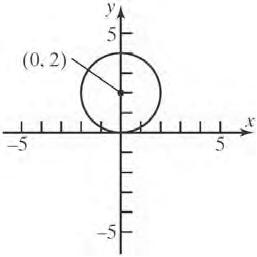

39. Center at (0, 0); containing point (–2, 3).
22 20304913 r
Equation: 2 22 22 (0)(0)13 13 xy xy
40. Center at (1, 0); containing point (–3, 2).
22 31201642025 r
Equation: 2 22 22 (1)(0)20 (1)20 xy xy
41. Endpoints of a diameter are (1, 4) and (–3, 2).
The center is at the midpoint of that diameter:
Center: 1(3)42,1,3 22
Radius: 22 (1(1))(43)415 r
Equation: 2 22 22 ((1))(3)5 (1)(3)5 xy xy
42. Endpoints of a diameter are (4, 3) and (0, 1).
The center is at the midpoint of that diameter:
Center: 4031 ,2,2 22
Radius: 22 (42)(32)415 r
Equation: 2 22 22 (2)(2)5 (2)(2)5 xy xy
43. 2 162 8
Cr r r
2 22 22 (2)((4))8 (2)(4)64
xy xy
45. (c); Center: 1; Radius = 2
46. (d) ; Center: 3,3 ; Radius = 3
47. (b) ; Center: 1,2 ; Radius = 2
48. (a) ; Center: 3,3 ; Radius = 3
49. The centers of the circles are: (4,-2) and (-1,5). The slope is 5(2)77 1455
m . Use the slope and one point to find the equation of the line.
7 (2)(4) 5 728 2 55 510728 7518
yx yx yx xy
50. Find the centers of the two circles: 22 22 22 4640 (44)(69)449 (2)(3)9 xyxy xxyy xy
Center: 2,3 22 22 22 6490 (69)(44)994 (3)(2)4 xyxy xxyy xy
Center: 3,2
Find the slope of the line containing the centers: 2(3)1 325 m
44. 2 2 49 7
A r r r
2 22 22 ((5))(6)7 (5)(6)49
xy xy
Find the equation of the line containing the centers: 1 3(2) 5 5152 513 5130 yx yx xy xy
51. Consider the following diagram:
(2,2)
Therefore, the path of the center of the circle has the equation 2 y
52. Consider the following diagram:
(7,7)
Therefore the path of the center of the circle has the equation 7 x .
53. Let the upper-right corner of the square be the point ,x y . The circle and the square are both centered about the origin. Because of symmetry, we have that x y at the upper-right corner of the square. Therefore, we get
The length of one side of the square is 2 x . Thus, the area is
square units.
54. The area of the shaded region is the area of the circle, less the area of the square. Let the upperright corner of the square be the point ,x y . The circle and the square are both centered about
the origin. Because of symmetry, we have that x y at the upper-right corner of the square. Therefore, we get
The length of one side of the square is 2 x . Thus, the area of the square is 2 23272 square units. From the equation of the circle, we have 6 r . The area of the circle is
square units. Therefore, the area of the shaded region is 3672 A
square units.
55. The diameter of the Ferris wheel was 250 feet, so the radius was 125 feet. The maximum height was 264 feet, so the center was at a height of 264125139 feet above the ground. Since the center of the wheel is on the y-axis, it is the point (0, 139). Thus, an equation for the wheel is:
22 2 2 2 0139125 13915,625
56. The diameter of the wheel is 520 feet, so the radius is 260 feet. The maximum height is 550 feet, so the center of the wheel is at a height of 550260290 feet above the ground. Since the center of the wheel is on the y-axis, it is the point (0, 290). Thus, an equation for the wheel is:
22 2 2 2 0290260 29067,600
57.

Refer to figure. Since the radius of the building is 60.5 m and the height of the building is 110 m,
then the center of the building is 49.5 m above the ground, so the y-coordinate of the center is 49.5. The equation of the circle is given by 222(49.5)60.53660.25 xy
58. Complete the square to find the equation of the circle representing the formula for the building. 22 222 781521184315213364 (39)58
xyy xy
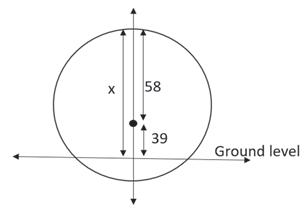
Refer to figure. The y coordinate of the center is 39. The radius is 58. Thus the height of the building is 58 + 39 = 97 m.
59. Center at (2, 3); tangent to the x-axis.
3 r
Equation: 222 22 (2)(3)3 (2)(3)9 xy xy
60. Center at (–3, 1); tangent to the y-axis.
3 r
Equation: 222 22 (3)(1)3 (3)(1)9 xy xy
61. Center at (–1, 3); tangent to the line y = 2. This means that the circle contains the point (–1, 2), so the radius is r = 1.
Equation: 222 22 (1)(3)(1) (1)(3)1 xy xy
62. Center at (4, –2); tangent to the line x = 1. This means that the circle contains the point (1, –2), so the radius is r = 3.
Equation: 222 22 (4)(2)(3) (4)(2)9 xy xy
63. a. Substitute 222 into : y mxbxyr
This equation has one solution if and only if the discriminant is zero.
b. From part (a) we know 22 22 (1)2 0 mxbmxbr . Using the quadratic formula, since the discriminant is zero, we get: 22 22 2 2 2 222222 2 2(1) bmbmbmrmr x b mb b r mr ymb b mrmrbr b bbb
The point of tangency is 22 ,.
c. The slope of the tangent line is m
The slope of the line joining the point of tangency and the center (0,0) is: 2 2 2 2 0 1 0 r b rb bm mr mr b
The two lines are perpendicular.
64. Let (,) hk be the center of the circle. 240 24 1 2 2 xy yx yx
The slope of the tangent line is 1 2 . The slope from (,) hk to (0, 2) is –2.
2 2 0 22 k h kh
The other tangent line is 27yx , and it has slope 2.
The slope from (,) hk to (3, –1) is 1 2 . 11 32 223 21 12 k h kh kh hk
Solve the two equations in and hk : 22(12) 224 30 0 kk kk k k
12(0)1 h
The center of the circle is (1, 0).
65. The slope of the line containing the center (0,0) and 1,22 is 220 22 10 .Then the slope of the tangent line is 12 4 22
So the equation of the tangent line is: 2 221 4 22 22 44 48222 2492
yx yx yx xy
66. 22 4640xyxy 22 22 (44)(69)449 (2)(3)9 xxyy xy
Center: (2, –3)
The slope of the line containing the center and 3,223 is 223(3)22 22 321
Then the slope of the tangent line is: 12 4 22
So, the equation of the tangent line is 2 223(3) 4 232 223 44 48212232 2411212
yx yx yx xy
67. The
Therefore, the equation of the tangent line
The slope of the line between the center
dede xyxyxyf dede xyxyxyf xxyy xydef
69. (b), (c), (e) and (g)
We need ,0hk and 0,0 on the graph.
70. (b), (e) and (g)
We need 0 h , 0 k , and hr
71. Answers will vary.
72. The student has the correct radius, but the signs of the coordinates of the center are incorrect. The student needs to write the equation in the standard form
22 2 x hykr .
22 2 2 2 3216 324 xy xy
Thus, ,3,2hk and 4 r .
Chapter 1 Review Exercises
1. 12 0,0 and 4,2 PP
a. 2212,4020 1642025 dPP
b. The coordinates of the midpoint are:
(,),1212 22 040242 ,,2,1 2222 xxyy xy
c. 2021 slope 4042 y x
d. For each run of 2, there is a rise of 1.
2. 12 1,1 and 2,3 PP
a.
2 2 12,2131 916255
b. The coordinates of the midpoint are:
(,),1212 22 12 13 , 22 121 ,,1 222
c.
d. For each run of 3, there is a rise of 4. 3.
12 4,4 and 4,8 PP a.
b. The coordinates of the midpoint are:
(,),1212 22 444884 ,,4,2 2222
c. 84 12 slope,undefined 440 y x
d. An undefined slope means the points lie on a vertical line. There is no change in x 4. 2 4 yx
5. x-intercepts: 4,0, 2 ; y-intercepts: 2,0,2 Intercepts: (4,0), (0,0),(2,0),(0,2),(0,2)
6. 2 23 x y
x-intercepts: y-intercepts: 2 23(0) 20 0 x x x 2 2 2(0)3 0 0 y y y
The only intercept is (0,0).
Test x-axis symmetry: Let yy 2 2 23() 23 same xy xy
Test y-axis symmetry: Let x x 2 2 2()3 23 different xy xy
Test origin symmetry: Let x x and yy . 2 2 2()3() 23 different xy xy
Therefore, the graph will have x-axis symmetry.
7. 22+4=16xy
Chapter1: Graphs
x-intercepts: y-intercepts:
2 2 2 +40=16 16 4 x x x
The intercepts are (4,0),(4,0),(0,2), and (0,2).
Test x-axis symmetry: Let yy
2 2 22 4=16 4=16 same xy xy
Test y-axis symmetry: Let x x
2 2 22 4=16 4=16 same xy xy
Test origin symmetry: Let x x and yy .
22 22 4=16 +4=16 same xy xy
Therefore, the graph will have x-axis, y-axis, and origin symmetry.
8. 42+2+1yxx
x-intercepts: y-intercepts:
42 22 2 2 0+2+1 011 10 1 xx xx x x
no real solutions
The only intercept is (0, 1).
42 (0)+2(0)+1 1 y
Test x-axis symmetry: Let yy 42 42 21 21 different yxx yxx
Test y-axis symmetry: Let x x
42 42 21 21 same yxx yxx
Test origin symmetry: Let x x and yy .
42 42 42 21 21 21 different yxx yxx yxx
Therefore, the graph will have y-axis symmetry. 9. 3 y xx
x-intercepts: y-intercepts:
3 2 0 01 011 xx xx xxx
3 (0)0 0 y 0,1,1xxx
The intercepts are (1,0), (0,0), and (1,0).
Test x-axis symmetry: Let yy 3 3 different yxx yxx
Test y-axis symmetry: Let x x 3 3 ()() different yxx yxx
Test origin symmetry: Let x x and yy 3 3 3 ()() same yxx yxx yxx
Therefore, the graph will have origin symmetry.
10. 22 20xxyy
x-intercepts: 22 2 (0)2(0)0 0 (1)0 xx xx xx 0,1xx
y-intercepts: 22 2 (0)020 20 (2)0 yy yy yy 0,2yy
The intercepts are (1,0), (0,0), and (0,2).
Test x-axis symmetry: Let yy 22 22 ()2()0 20 different xxyy xxyy
Test y-axis symmetry: Let x x 22 22 ()()20 20 different xxyy xxyy
Test origin symmetry: Let x x and yy 22 22 ()()()2()0 20 different xxyy xxyy
The graph has none of the indicated symmetries.
11.
12.
13.
222 2 2 2 22 ()() 234 2316 x hykr xy xy
222 22 2 22 ()() 121 121 x hykr xy xy
2 2 2 22 14 12 xy xy
Radius

y-intercepts: 2 2 2 014 (1)4 12 12 y y y y
3 or 1 yy
The intercepts are 3,0, 3,0, 0,1, and
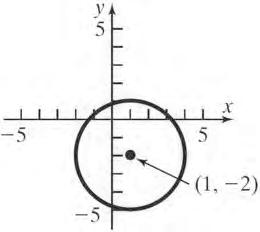
Center: (1, –2) Radius = 5

x-intercepts:
y-intercepts:
The intercepts are
16. Slope = –2; containing (3,–1)
17. vertical; containing (–3,4)
Vertical lines have equations of the form x = a, where a is the x-intercept. Now, a vertical line containing the point (–3, 4) must have an x-intercept of –3, so the equation of the line is 3. x The equation does not have a slopeintercept form.
18. y-intercept = –2; containing (5,–3) Points are (5,–3) and (0,–2) 2(3)11 0555 m
19. Containing the points (3,–4) and (2, 1) 1(4)5 5 231
11 (4)53 4515 511 or 511 yymxx yx yx yxxy
20. Parallel to 234 xy 234 324 324 33 24 33 xy yx yx yx
2 Slope; containing (–5,3) 3
11 2 3(5) 3 2 35 3 210 3 33 219 or 2319 33 yymxx yx yx yx yxxy
21. Perpendicular to 2 xy 2 2 xy yx
The slope of this line is 1 , so the slope of a line perpendicular to it is 1. Slope = 1; containing (4,–3) 11() (3)1(4) 4 3 7 or 7 yymxx yx yx yxxy
22. 4520 5420 4 4 5 xy yx yx
slope = 4 5 ; y-intercept = 4
x-intercept: Let y = 0. 45(0)20 420 5 x x x
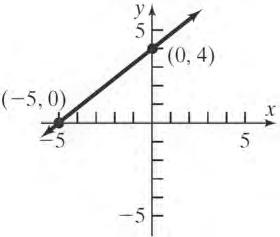
23. 111 236 111 326 31 22 xy yx yx
slope = 3 2 ; 1 -intercept 2 y x-intercept: Let y = 0. 111 (0) 236 11 26 1 3 x x x

24. 2312 xy x-intercept: y-intercept: 23(0)12 212 6 x x x
The intercepts are 6,0 and 0,4

25. 11 2 23xy x-intercept: y-intercept: 11 (0)2 23 1 2 2 4 x x x
11(0)2 23 1 2 3 6 y y y
The intercepts are 4,0 and 0,6 .

26. 3 y x

27. y x
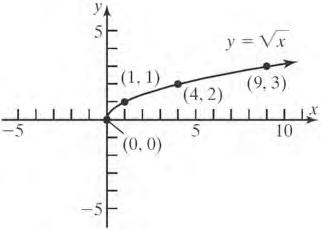
28. slope = 2 3 , containing the point (1,2)

29. Find the distance between each pair of points. 22 , 22 , 22 , (13)(14)4913 (21)(31)9413 (23)(34)25126
AB BC AC d d d
Since AB = BC, triangle ABC is isosceles.
30. Given the points (2,0),(4,4),AB and (8,5). C
a. Find the distance between each pair of points.
22 22 22 ,(4(2))(40) 416 2025 ,(8(4))(54) 1441 145 ,(8(2))(50) 10025 12555 dAB dBC dAC
222 222 ,,, 20125145 20125145 145145 dABdACdBC
The Pythagorean Theorem is satisfied, so this is a right triangle.
b. Find the slopes:
404 2 4(2)2 541 8412 5051 82102 AB BC AC m m m
Since 1 21 2 mmABAC , the sides AB and AC are perpendicular and the triangle is a right triangle.
31. Endpoints of the diameter are (–3, 2) and (5,–6). The center is at the midpoint of the diameter:
Center:
26 35 ,1,2 22
Radius: 22 (1(3))(22) 1616 3242
Equation:
2 22 22 1242 1232
32. 15 slope of 1 62 15 slope of 1 82 AB AC
Therefore, the points lie on a line.
Chapter 1 Test
1.
2. The coordinates of the midpoint are:
b. If x increases by 3 units, y will decrease by 2 units.
4. 2 9 yx 5. 2 y x
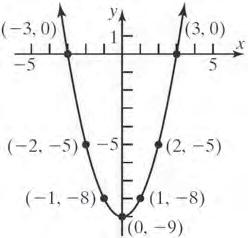
6. 2 9 xy
2 (0)9 9 y y
The intercepts are 3,0, 3,0, and 0,9.
Test x-axis symmetry: Let yy
2 2 9 9 different xy xy
Test y-axis symmetry: Let x x 2 2 9 9 same xy xy
Test origin symmetry: Let x x and yy
2 2 9 9 different xy xy
Therefore, the graph will have y-axis symmetry.
7. Slope = 2 ; containing (3,4) 11() (4)2(3) 426 22 yymxx yx yx yx

8. ()()222 x hykr
22 2 22 4(3)5 4325 xy xy
General form: 22 22 22 4325 8166925 860 xy xxyy xyxy
9. 22 22 22 222 4240 424 (44)(21)441 (2)(1)3 xyxy xxyy xxyy xy
Center: (–2, 1); Radius = 3
Chapter1: Graphs
Perpendicular line Any
Section 2.1
1. 1,3
2.
Chapter 2
Functions and Their Graphs
16. explicitly
17. a. Domain: {0,22,40,70,100} in C⁰ Range: {1.031, 1.121, 1.229, 1.305, 1.411} in kg/m3 b.
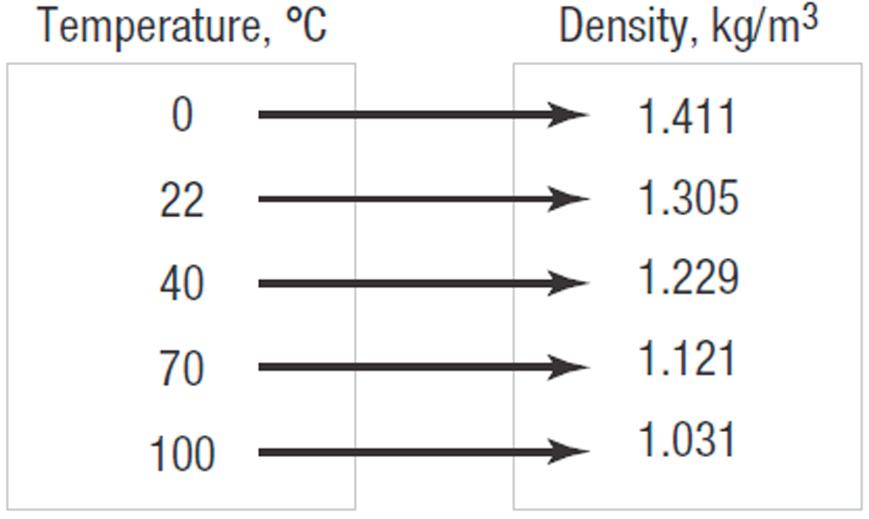
3. We must not allow the denominator to be 0. 404xx ; Domain: 4 xx .
4. 325 22 1 x x x
Solution set: |1xx or ,1
5. 52
6. radicals
7. independent; dependent
8. a
9. c
10. False; g 0
11. False; every function is a relation, but not every relation is a function. For example, the relation 22 1 xy is not a function.
12. verbally, numerically, graphically, algebraically
13. False; if the domain is not specified, we assume it is the largest set of real numbers for which the value of f is a real number.
14. False; if x is in the domain of a function f, we say that f is defined at x, or f(x) exists.
15. difference quotient
c. {(0, 1.411), (22, 1.305), (40, 1.229), (70, 1.121), (100, 1.031)}
18. a. Domain: {1.80, 1.78, 1.77}
Range: {87.1, 86.9, 92.0, 84.1, 86.4} b.
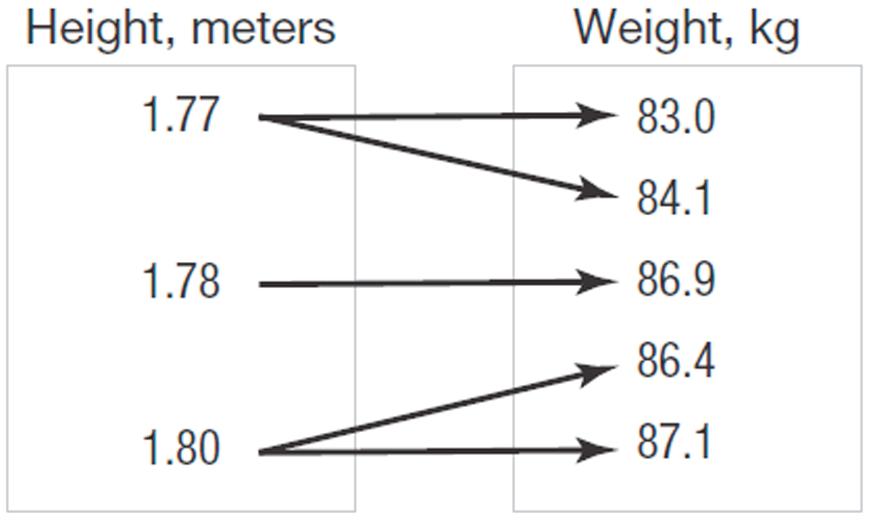
c. {(1.80, 87.1), (1.78, 86.9), (1.77, 83.0), (1.77, 84.1), (1.80, 86.4)}
19. Domain: {Elvis, Colleen, Kaleigh, Marissa}
Range: {Jan. 8, Mar. 15, Sept. 17}
Function
20. Domain: {Bob, John, Chuck}
Range: {Beth, Diane, Linda, Marcia} Not a function
21. Domain: {20, 30, 40}
Range: {200, 300, 350, 425} Not a function
22. Domain: {Less than 9th grade, 9th-12th grade, High School Graduate, Some College, College Graduate}
Range: {$18,120, $23,251, $36,055, $45,810, $67,165}
Function
23. Domain: {-3, 2, 4}
Range: {6, 9, 10} Not a function
24. Domain: {–2, –1, 3, 4}
Range: {3, 5, 7, 12} Function
25. Domain: {1, 2, 3, 4} Range: {3} Function
26. Domain: {0, 1, 2, 3}
Range: {–2, 3, 7} Function
27. Domain: {-4, 0, 3}
Range: {1, 3, 5, 6} Not a function
28. Domain: {-4, -3, -2, -1}
Range: {0, 1, 2, 3, 4} Not a function
29. Domain: {–1, 0, 2, 4}
Range: {-1, 3, 8} Function
30. Domain: {–2, –1, 0, 1}
Range: {3, 4, 16} Function
31. Graph 2 234yxx . The graph passes the Vertical-Line Test. Thus, the equation represents a function.
32. Graph 3 y x . The graph passes the VerticalLine Test. Thus, the equation represents a function.
33. Graph 1 y x . The graph passes the VerticalLine Test. Thus, the equation represents a function.
34. Graph y x . The graph passes the VerticalLine Test. Thus, the equation represents a function.
35. 22 8 x y
Solve for 2 :8 yyx For 0,22xy . Thus, 0,22 and 0,22 are on the graph. This is not a function, since a distinct x-value corresponds to two different y-values.
36. 12 y x For 0,1xy . Thus, (0, 1) and (0, –1) are on the graph. This is not a function, since a distinct xvalue corresponds to two different y-values.
37. 2 x y
Solve for : y yx For 1,1xy . Thus, (1, 1) and (1, –1) are on the graph. This is not a function, since a distinct x-value corresponds to two different y-values.
38. 2 1 xy
Solve for :1 y yx For 0,1xy . Thus, (0, 1) and (0, –1) are on the graph. This is not a function, since a distinct xvalue corresponds to two different y-values.
39. Graph 3 y x . The graph passes the VerticalLine Test. Thus, the equation represents a function.

40. Graph 31 2 x y x . The graph passes the Vertical-Line Test. Thus, the equation represents a function.
41. 23 y x
Solve for y: 23 or (23) yxyx
For 1,5 or 5xyy . Thus, 1,5 and 1,5 are on the graph. This is not a function, since a distinct x-value corresponds to two different y-values.
42. 2241xy
Solve for y: 22 22 2 2 2 41 41 1 4 1 2 xy yx x y x y
For 1 2, 2 xy . Thus, 1 2, 2 and 1 2, 2 are on the graph. This is not a function, since a distinct x-value corresponds to two different y-values.
43. 2 324fxxx
a. 2 0302044 f
b. 2 1312143241 f
c. 2 1312143243 f
d. 2 2 324324fxxxxx
e. 22 324324fxxxxx
f. 2 2 2 2 131214 321224 363224 381 fxxx xxx xxx xx
g. 2 2 2322241244 fxxxxx
h. 2 22 22 324 32224 363224 fxhxhxh xxhhxh xxhhxh
44. 2 21 f xxx
a. 2 020011 f
b. 2 121112 f
c. 2 121114 f
d. 2 2 2121 f xxxxx
e. 22 2121 f xxxxx
f. 2 2 2 2 12111 22111 242 232 fxxx xxx xxx xx
g. 2 2 22221821 f xxxxx h. 2 22 22 2()1 221 2421 fxhxhxh x xhhxh xxhhxh
45. 2 1 x fx x a. 2 00 00 1 01 f
b. 2 11 1 2 11 f
c. 2 111 1 112 11 f
d.
22 1 1 x x fx x x
e. 2211 x x fx xx
47.
e.
f.
g.
2 2 1 1 44 x x
2211 44 xx fx
2 2 21 41 2 2424 x x fx
4 fxx
a.
b.
c. 114145 f
d. 44fxxx
e. 44fxxx
f. 114fxx
g. 22424fxxx
h. 4 fxhxh
48. 2 f xxx
a. 2 00000 f
b. 2 1112 f
c. 2 1111100 f
d. 2 2 f xxxxx
e. 22 f xxxxx
f. 2 2 2 111 211 32 fxxx x xx xx
g. 2 2 22242 f xxxxx
h. 2 22 2 fxhxhxh x xhhxh
49. 21 35 x fx x
a. 201 011 0 305055 f
b.
211 2133 1 3153522 f
211 2111 1 3153588
21 2121 353535 x xx fx xxx
e. 2121 3535 x x fx xx
22 11 111 123 fx xx
22
2 1 1 2 fxh xh
51. ()54fxx
Domain: is any real number xx
52. 2 ()2fxx
Domain: is any real number xx
53. 2 1 () 28 x fx x
Domain: is any real number xx
54. 2 2 () 1 x fx x
Domain: is any real number xx
55. 2 () 16 x gx x 2 2 160 164 x x x
Domain: 4,4xxx
56. 2 2 () 4 x hx x 2 2 40 42 x x x
Domain: 2,2xxx
57. 3 2 () x Fx x x 3 2 2 0 (1)0 0,1 xx xx xx
Domain: 0 xx
58. 3 4 () 4 x Gx x x 3 2 2 40 (4)0 0,4 0,2 xx xx xx xx
Domain: 2,0,2xxxx
59. ()312hxx 3120 312 4 x x x
Domain: 4 xx
Chapter 2: Functions and Their Graphs
60. ()1 Gxx 10 1 1 x x x
Domain: 1 xx
61. () 231 x px x 2310 231 231 or 231 24 22 2 1
x x xx xx xx
Domain: 2,1xxx
62. 1 () 314 x px x 3140 314 314 or 314 33 35 5 1 3
x x xx xx xx
Domain: 5 1, 3 xxx
63. () 4 x fx x
40 4 x x
Domain: 4 xx
64. 2 () x x qx 20 2 2 x x x
Domain: 2 xx
65. 4 () 321 t Pt t
40 4 t t Also 3210 t 3210 321 7 t t t
Domain: 4,7ttt
66. 3 () 2 z hz z 30 3 z z Also 20 2 z z
Domain: 3,2zzz
67. 3 ()54 fxx
Domain: is any real number xx
68. 3 22 ()7 g tttt
Domain: is any real number tt .
69. 5 2 1 () 514 t Mt tt 2 5140 (2)(7)0 20 or 70 2 7
tt tt tt tt
Domain: 2,7ttx
70. 5 2 () 298 p Np p 2 2 2980 2(49)0 2(7)(7)0 70 or 70 7 7
p p pp pp pp
Domain: 7,7ppx
71. ()34()23 f xxgxx a. ()()342351 f gxxxx
Domain: is any real number xx .
b. ()()(34)(23) 3423 7 fgxxx xx x
Domain: is any real number xx .
c. 2 2 ()()(34)(23) 69812 612 fgxxx xxx xx
Domain: is any real number xx .
d. 34 () 23 fx x gx
3 23023 2 xxx
Domain: 3 2 xx
e. ()(3)5(3)115116 fg
f. ()(4)4711 fg
g. 2 ()(2)6(2)2122421210 fg
h. 3(1)4 347 (1)7 2(1)3231 f g
72. ()21()32 fxxgxx
a. ()()213251 f gxxxx
Domain: is any real number xx
b. ()()(21)(32) 2132 3 fgxxx xx x
Domain: is any real number xx
c. 2 2 ()()(21)(32) 6432 62 fgxxx xxx xx
Domain: is any real number xx .
d. 21 () 32 fx x gx
Domain: 2 3 xx
e. ()(3)5(3)115114 fg
f. ()(4)431 fg
g. 2 ()(2)6(2)22 6(4)22 242220 fg
h. 2(1)1 213 (1)3 3(1)2321 f g
73. 2 ()1()2 f xxgxx
a. 22 ()()1221 f gxxxxx
Domain: is any real number xx
b. 2 2 2 ()()(1)(2) 12 21 f gxxx xx xx
Domain: is any real number xx
c. ()()(1)(2)22232 f gxxxxx
Domain: is any real number xx
d. 2 1 () 2 f x x g x
Domain: 0 xx
e. 2 ()(3)2(3)31 2(9)31 183120 fg
f. 2 ()(4)2(4)41 2(16)41 324129 fg
g. ()(2)2(2)2(2)32 2(8)2(4) 1688 fg
h. 2 1100 (1)0 2(1)2 2(1) f g
74. 23 ()23()41 fxxgxx
Chapter 2: Functions and Their Graphs
a. 23 32 ()()2341 424 fgxxx xx
Domain: is any real number xx .
b. 23 23 32 ()()2341 2341 422 fgxxx xx xx
c. 23 532 ()()2341 81223 fgxxx xxx
d.
Domain: 3 2 2 xx
e. 32 ()(3)4(3)2(3)4 4(27)2(9)4 108184130
f. 32 ()(4)4(4)2(4)2 4(64)2(16)2 256322222
g. 532 ()(2)8(2)12(2)2(2)3 8(32)12(8)2(4)3 2569683363
h. 2 3 2(1)32(1)3 235 (1)1 4(1)1415 4(1)1
g
()()35 fxxgxx
a. ()()35 f gxxx
Domain: 0 xx
b. ()()(35)35 fgxxxxx
Domain: 0 xx
c. ()()(35)35 f gxxxxxx
Domain: 0 xx
d. () 35 f x x gx 0 and 350 5 35 3 xx xx
Domain: 5 0 and 3 xxx
e. ()(3)33(3)5 39534 fg
f. ()(4)43(4)5 21255 fg
g. ()(2)3(2)252 62522 fg
h. 1111 (1) 3(1)53522 f g
76. ()() f xxgxx
a. ()() f gxxx
Domain: is any real number xx
b. ()() f gxxx
Domain: is any real number xx .
c. ()() f gxxxxx
Domain: is any real number xx
d. () x f x g x
Domain: 0 xx
e. ()(3)33336 fg
f. ()(4)44440 fg
g. ()(2)22224 fg
h. 1 1 (1)1 11 f g
77. 11 ()1() fxgx x x
a. 112 ()()11 fgx x xx
Domain: 0 xx
b. 11 ()()11 fgx xx
Domain: 0 xx .
c. 2 1111 ()()1 fgx xxx x
Domain: 0 xx
d.
Domain: 0 xx .
e. 25 ()(3)1 33 fg
f. ()(4)1 fg
g. 2 11113 ()(2) 2244 (2) fg
h. (1)112 f g
78. ()1()4 f xxgxx
a. ()()14 f gxxx 10 and 40 1 and 4 4 xx xx x
Domain: 14xx
b. ()()14 f gxxx 10 and 40 1 and 4 4 xx xx x
Domain: 14xx .
c. 2 ()()14 54 fgxxx xx 10 and 40 1 and 4 4 xx xx x
Domain: 14xx
d. 11 () 4 4 fxx x g x x 10 and 40 1 and 4 4 xx xx x
Domain: 14xx
e. ()(3)3143 2121 fg
f. ()(4)4144 30303 fg
g. 2 ()(2)(2)5(2)4 41042 fg h. 110 (1)00 413 f g
79. 234 ()()3232 x x fxgx xx
a. 234 ()() 3232 23463 3232 xx fgx xx xxx xx 2 3 320 32 x xx
Domain: 2 3 xx .
Chapter 2: Functions and Their Graphs
b. 234 ()() 3232 23423 3232 xx fgx xx xxx
c.
d.
320 2 32 3 x xx
e. 6(3)3 18321 ()(3)3 3(3)2927 fg
f. 2(4)3835 1 ()(4) 3(4)2122102 fg
g.
2 2 22 8(2)12(2) ()(2) 3(2)2 8(4)243224567 162 624 fg
h. 2(1)3 235 (1) 4(1)44
g
80. 2 ()1() fxxgx x
a. 2 ()()1 fgxx x 10 and 0 1 xx x
Domain: 1,and 0 xxx
b. 2 ()()1 fgxx x 10 and 0 1 xx x
Domain: 1,and 0 xxx
c. 221 ()()1 x fgxx xx
10 and 0 1 xx x
Domain: 1,and 0 xxx
d. 11 () 2 2 fxxx x g x
10 and 0 1 xx x
Domain: 1,and 0 xxx .
e. ()(3)31422228 3333 fg
f. 21 ()(4)41542 fg
g. 22123 ()(2)3 22 fg
h. 1112 (1) 22 f g
81. 1 ()31()()6 2 fxxfgxx 1 631() 2 7 5() 2 7 ()5 2 x xgx xgx gxx
82. 2 11 ()() fxxfx xg x x
2 2 2 1 1 () 1 1 () 1 1 1(1)1 11 x x gx xx x x x gx x xx xx xxx
83. ()43fxx
()()4()3(43) 44343 4 4 fxhfxxhx hh xhx h h h
84. ()31 f xx ()()3()1(31) 33131 3 3 fxhfxxhx hh xhx h h h
85. 2 ()4fxx
22 222 2 ()() ()4(4) 244 2 2 fxhfx h xhx h xxhhx h xhh h x h
86. 2 ()32fxx 22 222 2 ()() 3()2(32) 363232 63 63 fxhfx h xhx h xxhhx h xhh h x h
87. 2 ()4fxxx 22 222 2 ()() ()()4(4) 244 2 21 fxhfx h xhxhxx h xxhhxhxx h xhhh h xh
88. 2 326fxxx
2 2 222 2222 326326 32226326 36323632 632 fxhfx h xhxhxx h xxhhxhxx h x xhhhxxhhh hh xh
Chapter 2: Functions and Their Graphs
89. 5 () 43
94.
xhx h x hxxhx h x hx xhx hxhx xxhhx hxhx xhh hxhx xh xhx xh xhx 98. 1 2 fx x ()() 11 22 22 22 2222 2222 2(2) (2)2(2)2 22 (2)2(2)2 (2)2(2)2 1 (2)2(2)2
22 2222 22 22 22 222 2 22 22 4()4 4()44()4 4()4 4()(4) 4()4 4(2)(4) 11 2 11 2 4()4 (2) 4()4
fxhfx h xhx h xxh hxxh xxhxxh hxxhxxh xxh hxxhxhx xxh hxxhxhx h hxxhxhx xxhxhx
99. 2 2 1123 028 0(4)(2) 40 or 20 4 or 2 xx xx xx xx xx
The solution set is: 2,4
100. 753 1664 735 1646 5712 61616 55 616 563 1658 x x x x x
The solution set is: 3 8
101. 32 ()245 and (2)5 fxxAxxf 32 (2)2(2)(2)4(2)5 516485 5419 144 147 42 fA A A A A
102. 2 ()34 and (1)12 fxxBxf : 2 (1)3(1)(1)4 1234 5 fB B B
103. 38 () and (0)2 2 x fxf xA 3(0)8 (0) 2(0) 8 2 28 4 f A A A A
104. 21 () and (2) 342 xB fxf x 2(2) (2) 3(2)4 14 210 54 1 B f B B B
105. Let x represent the length of the rectangle. Then, 2 x represents the width of the rectangle since the length is twice the width. The function for the area is: 2 2 1 () 222 xx A xxx
106. Let x represent the length of one of the two equal sides. The function for the area is: 2 11 () 22 A xxxx
107. Let x represent the number of hours worked. The function for the gross salary is: ()16 Gxx
108. Let x represent the number of items sold. The function for the gross salary is: ()10100Gxx
1.75 seconds Hx x x x x
0 Hx 2 2 2 0204.9 204.9 4.0816 2.02 seconds x x x x
2 12013120137 meters H
2 2 1.120131.120131.21 2015.734.27 meters 1.220131.220131.44 2018.721.28 meters
b. 2 2 2 15 152013 513 0.3846 0.62 seconds Hx x x x x
2 2 2 10 102013 1013 0.7692 0.88 seconds Hx x x x x
115.
TxVPxVxPx
117. a.
232 232 32 ()()() 1.22200.05265500 1.22200.05265500 0.050.8155500 PxRxCx xxxxx xxxxx xxx
b. 32 (15)0.05(15)0.8(15)155(15)500 168.751802325500 $1836.25 P
c. When 15 hundred smartphones are sold, the profit is $1836.25.
118. a. P is the dependent variable; a is the independent variable
b. 2 (20)0.027(20)6.530(20)363.804 10.8130.6363.804
244.004
In 2015 there are 244.004 million people who are 20 years of age or older.
c. 2 (0)0.027(0)6.530(0)363.804 363.804
In 2015 there are 363.804 million people.
119. a. 2 2 2 ()0.05 2.20.050.4v15 0.05 ()2.2;0.4v15 ()()() 2.615 Bvv vv v Rvv DvRvBv v
b. 2 (60)0.05(60)2.6(60)15 18015615 321
c. The car will need 321 feet to stop once the impediment is observed.
120. a. 2 hxx 222 hababab hahb 2 hxx has the property.
b. 2 g xx 2 22 2 g ababaabb Since
2222 2 aabbabgagb , 2 () g xx does not have the property.
Section 2.1: Functions
c. 52Fxx
52552Fababab Since 5525252 ababFaFb , 52Fxx does not have the property.
d. 1 Gx x
111 GabGaGb abab 1 Gx x does not have the property.
Chapter 2: Functions and Their Graphs
124. No. The domain of f is is any real number xx , but the domain of g is 1 xx
125. 3 3 ( ) x x yourage 126. Answers will vary.
127. 22 (12)16 xy
x-intercept (y=0): 22 2 (12)016 (12)16 (12)4 124 16,8 x x x x xx
(16,0),(8,0) y-intercept (x=0): 22 22 2 (012)16 (12)16 16144128 y y y
There are no real solutions so there are no yintercepts.
Symmetry: 22 22 (12)()16 (12)16 xy xy
This shows x-axis symmetry.
128. 2 2 38 3(1)81 yxx y
There is no solution so (-1,-5) is NOT a solution.
2 2 38 3(4)84 481632 yxx y
So (4,32) is a solution.
2 2 38 3(9)89 24324219171 yxx y
So (9,171) is NOT a solution.
xy yx yx
129. 31012 10312 36 105
The slope of the line is 3 10 . The slope of a perpendicular line would be 10 3 130 32 32 32 2 2 9218 29180 (2)(918)0 (2)9(2)0 (9)(2)0 (3)(3)(2)0 xxx xxx xxx xxx xx xxx
(3)0 or (3)0 or (2)0 3,3,2 xxx xxx
The solution set is: 3,3,2
abxacd aacdbx acdbx dbx a c
2 22 22 22 222 2222
(47)3(35)8 (47) 1221(2440) (47) 12212440124021 (47)(47) 124021 (47)
Section 2.2
1. 22416xy x-intercepts:
2 2 2 4016 16 44,0,4,0 x x x
2. False; 22 222 02 0 xy y y y
The point 2,0 is on the graph.
3. vertical
4. 53 f
5. 2 4 fxax
2 1422aa
6. False. The graph must pass the Vertical-Line Test in order to be the graph of a function.
7. False; e.g. 1 y x .
8. True
9. c
10. a
11. a. (0)3 since (0,3) is on the graph. f (6)3 since (6,3) is on the graph. f
b. (6)0 since (6,0) is on the graph. f (11)1 since (11,1) is on the graph. f
c. (3) is positive since (3)3.7. ff
d. (4) is negative since (4)1. ff
Section 2.2: The Graph of a Function
e. ()0 when 3,6, and 10. fxxxx
f. ()0 when 36, and 1011.fxxx
g. The domain of f is 611xx or 6,11
h. The range of f is 34yy or 3,4 .
i. The x-intercepts are 3 , 6, and 10.
j. The y-intercept is 3.
k. The line 1 2 y intersects the graph 3 times.
l. The line 5 x intersects the graph 1 time.
m. ()3 when 0 and 4. fxxx
n. ()2 when 5 and 8. fxxx
12. a. (0)0 since (0,0) is on the graph. f (6)0 since (6,0) is on the graph. f
b. (2)2 since (2,2) is on the graph. f (2)1 since (2,1) is on the graph. f
c. (3) is negative since (3)1. ff
d. (1) is positive since (1)1.0. ff
e. ()0 when 0,4, and 6. fxxxx
f. ()0 when 04.fxx
g. The domain of f is 46xx or 4,6
h. The range of f is 23yy or 2,3
i. The x-intercepts are 0, 4, and 6.
j. The y-intercept is 0.
k. The line 1 y intersects the graph 2 times.
l. The line 1 x intersects the graph 1 time.
m. ()3 when 5. fxx
n. ()2 when 2. fxx
13. Not a function since vertical lines will intersect the graph in more than one point.
Chapter 2: Functions and Their Graphs
a. Domain: 1 or 1 xxx ;
Range: is any real number yy
b. Intercepts: (1,0),(1,0)
c. Symmetry about the x-axis, y-axis and the origin
14. Function
a. Domain: is any real number xx ;
Range: 0 yy
b. Intercepts: (0,1)
c. None
15. Function
a. Domain: xx ; Range: 11yy
b. Intercepts: ,0, ,0, (0,1) 22
c. Symmetry about y-axis.
16. Function
a. Domain: xx ; Range: 11yy
b. Intercepts: ,0, ,0, (0,0)
c. Symmetry about the origin.
17. Not a function since vertical lines will intersect the graph in more than one point.
a. Domain: 0 xx ; Range: is any real number yy
b. Intercepts: (0,0)
c. Symmetry about the x-axis
18. Not a function since vertical lines will intersect the graph in more than one point.
a. Domain: 22xx ; Range: 22yy
b. Intercepts: (2,0)(2,0)(0,2)(0,2)
c. Symmetry about the x-axis, y-axis and the origin
19. Function
a. Domain: 03xx ; Range: <2 yy
b. Intercepts: (1, 0)
c. None
20. Function
a. Domain: 04xx ; Range: 03yy
b. Intercepts: (0, 0)
c. None
21. Function
a. Domain: is any real number xx ; Range: 2 yy
b. Intercepts: (–3, 0), (3, 0), (0,2)
c. Symmetry about y-axis.
22. Function
a. Domain: 3 xx ; Range: 0 yy
b. Intercepts: (–3, 0), (2,0), (0,2)
c. None
23. Function
a. Domain: is any real number xx ; Range: 3 yy
b. Intercepts: (1, 0), (3,0), (0,9)
c. None
24. Function
a. Domain: is any real number xx ; Range: 5 yy
b. Intercepts: (–1, 0), (2,0), (0,4)
c. None
25. 2 ()32 fxxx
a. 2 (1)31122 f
The point 1,2 is on the graph of f
b. 2 (2)32228 f
The point 2,8 is on the graph of f.
c. Solve for x : 2 2 1 3 232 03 0310, xx xx xxxx (0, –2) and 1 3 ,2 are on the graph of f .
d. The domain of f is is any real number xx
e. x-intercepts:
2 =0320 2 3210,1 3 fxxx xxxx
f. y-intercept: 2 0=30022 f
26. 2 ()35 f xxx
a. 2 (1)315182 f
The point 1,2 is not on the graph of f.
b. 2 (2)3252=22 f
The point 2,22 is on the graph of f
c. Solve for x : 22 1 3 2353520 3120,2 xxxx xxxx (2, –2) and 1 3 ,2 on the graph of f
d. The domain of f is is any real number xx
e. x-intercepts:
2 5 3 =0350 3500, fxxx xxxx
f y-intercept:
2 030500 f
Section 2.2: The Graph of a Function
27. 2 () 6 x fx x
a. 325 (3)14 363 f
The point 3,14 is not on the graph of f
b. 426 (4)3 462 f
The point 4,3 is on the graph of f.
c. Solve for x : 2 2 6 2122 14 x x xx x (14, 2) is a point on the graph of f
d. The domain of f is 6 xx .
e. x-intercepts: 2 =00 6 202 x fx x x x f y-intercept: 021 0 063 f
28. 2 2 () 4 x fx x a. 2 123 (1) 145 f
The point 3 1, 5 is on the graph of f.
b. 2 0221 (0) 0442 f
The point 1 0, 2 is on the graph of f
c. Solve for x : 2 2 2 12 424 24 02 1 2100 or 2 x xx x xx xxxx 111 0, and , 222 are on the graph of f .
Chapter 2: Functions and Their Graphs
d. The domain of f is 4 xx
e. x-intercepts:
This is impossible, so there are no xintercepts.
f. y-intercept:
a. 4 2 12(1)12 (1)6 2 (1)1
The point (–1,1) is on the graph of f.
b. 4 2 12(3)972486 (3) 105 (3)1
The point 486 3, 5
c. Solve for
is on the graph of f.
are on the graph of f
d. The domain of f is is any real number xx
e. x-intercept:
f. y-intercept:
1 2 112 2 13 23 2 22 f
The point 12 , 23 is on the graph of f
b. 2(4)8 (4)4 422 f
The point 4,4 is on the graph of f
c. Solve for x : 2 2 122 2 x x x x x (–2,1) is a point on the graph of f
d. The domain of f is 2 xx .
e. x-intercept: 2 =0020 2 0 x fxx x x f y-intercept: 0 00 02 f
31. a. ()(2)(2)(2)213 fgfg
b. ()(4)(4)(4)1(3)2 fgfg
c. ()(6)(6)(6)011 fgfg
d. ()(6)(6)(6)101 gfgf
e. ()(2)(2)(2)2(1)2 fgfg
f. (4) 11 (4) (4)33 ff gg
32. 2 2 136 2.73.5 x hxx v
a. We want 1510 h
2 2 2 2 13615 2.7153.510
30,600 34 900 30 ft/sec v v v v
The ball needs to be thrown with an initial velocity of 30 feet per second.
Section 2.2: The Graph of a Function
b.
which simplifies to
c. Using the velocity from part (b),
The ball will be 15.56 feet above the floor when it has traveled 9 feet in front of the foul line.
d. Select several values for x and use these to find the corresponding values for h. Use the results to form ordered pairs ,x h . Plot the points and connect with a smooth curve.
c. From part (a) we know the point 8,10.4 is on the graph and from part (b) we know the point 12,9.9 is on the graph. We could evaluate the function at several more values of x (e.g. 0 x , 15 x , and 20 x ) to obtain additional points.
Thus, some points on the graph are 0,3.5 ,
5,13.2 , and 15,10 . The complete graph is given below.

Some additional points are
0,6 ,
15,8.4 and 20,3.6. The complete graph is given below.
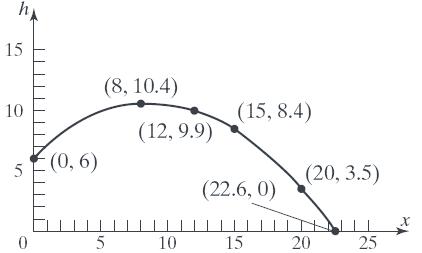
No; when the ball is 15 feet in front of the foul line, it will be below the hoop. Therefore it cannot go through the hoop.
In order for the ball to pass through the hoop, we need to have 1510 h .
